Archived Storm Damage Blog Posts
5 Steps to Eradicate Lingering Water Damage Odors
6/25/2024 (Permalink)
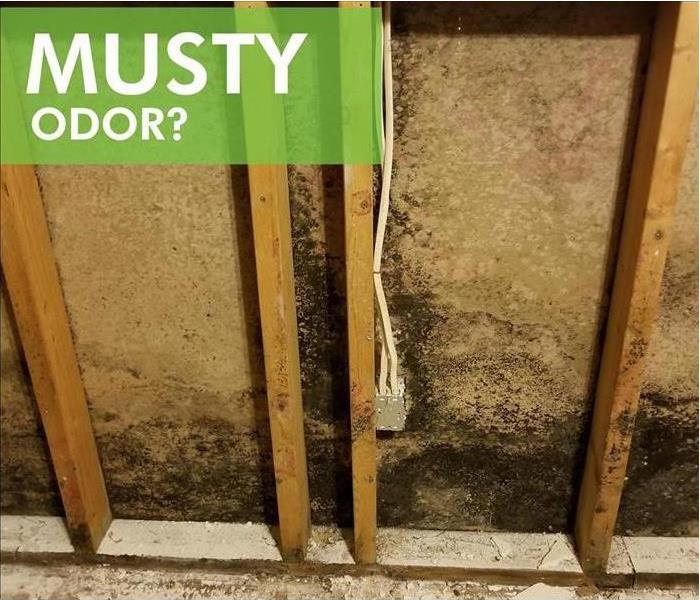 A strong, musty odor may indicate hidden mold behind drywall
A strong, musty odor may indicate hidden mold behind drywall
Below Are 5 Key Components To Eliminate The Problem
For businesses in Woodland Hills, OK, even a little water damage can quickly lead to mold growth and persistent odors that can be frustrating. If flood water is the culprit, it means other contaminants, such as sewage, have made their way into the building. When a lingering odor persists, a water remediation and water restoration professional can get your business back to normal. Below are five key components to eliminate the problem.
1. Find the Source
While sometimes the problem is obvious sewage loss, such as an overflowing toilet, oftentimes, there is hidden damage. The first hint of a musty odor means mold is growing somewhere. If there hasn’t been an obvious water issue, check dark, damp locations prone to extra moisture as well as porous materials, such as drywall, wood, and carpet. Inspect pipes, appliances, roofs, and foundation for signs of damage.
2. Repair the Source
Once the culprit is known, immediate repairs should be made to prevent it from spreading, especially if it a burst pipe. After the leak, crack or other issue is fixed, monitor it to ensure the issue doesn’t reappear.
3. Dry Affected Area, Items
After the source is solved, drying out is imperative. Any items that have come in contact with the water damage should be removed. Carpeting and drywall may also need to be replaced. A professional will have the tools and expertise to ensure proper drying.
4. Eradicate the Mold
Mold spores can quickly spread to unaffected areas, causing that pesky odor to remain after the repairs are done. Mold remediation experts use specialized equipment to safely and thoroughly removed mold growth.
5. Clean and Deodorize
From documents to furniture and even equipment, lingering odors can persist if they are not properly cleaned and deodorized. Restoration specialist use various methods to eliminate odors and prevent future problems. These methods allow for many items that seem like a lost cause to be salvaged.
Mold growth after experiencing water damage doesn’t have mean long-term odors. Taking action early and getting the right help can make it “Like it never even happened.”
After a storm, No Job Is Too Big or Small for SERVPRO of South Tulsa County
4/19/2024 (Permalink)
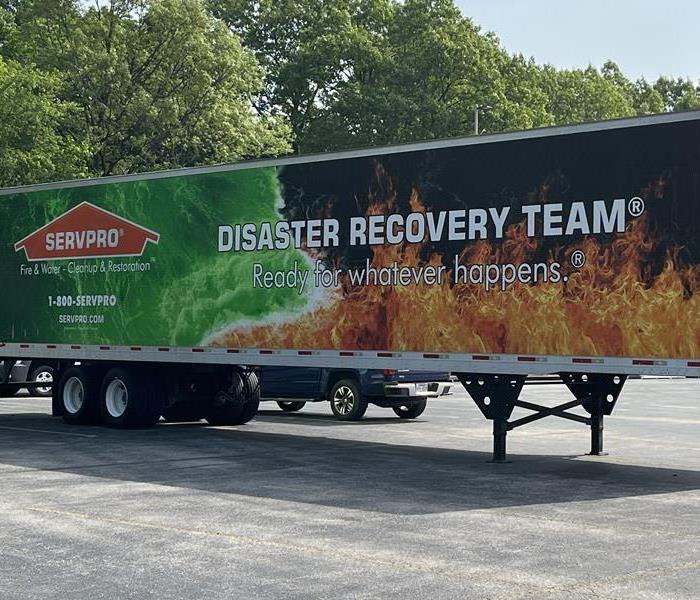 This 52 foot dry van trailer holds additional equipment for our teams to use during storm events
This 52 foot dry van trailer holds additional equipment for our teams to use during storm events
Whether a flood or torrential rainstorm, SERVPRO of South Tulsa County can help. When water damage affects your home or business, you need it to be restored ASAP! Our trained professionals have decades of experience in restoring residential and commercial properties. SERVPRO of South Tulsa County is the trusted choice of insurance companies because of our knowledge and experience.
After any water damage situation, your primary focus should be safety first:
- Is it safe to stay in the home or business?
- Electrical and "slip and fall" hazards are some of the most prevalent concerns.
- Only do activities that are safe for you to perform.
- Wet materials can be VERY heavy. Be careful!
The first 24 hours are the most important after flooding to prevent secondary damage. Within four hours of loss notification, a SERVPRO professional will be on-site to ensure the water damage is handled properly.
Step 1:
Our trained technician will inspect the water damage to determine the extent of damage and review the inspection with you. This is the best time to ask questions and communicate expectations.
Step 2:
Our team of professionals will extract the excess water and prepare the affected areas for drying. We take all the necessary steps to help protect your home or business, as well as your personal belongings and contents.
Step 3:
Our professional team members will monitor your home or business to ensure the affected areas and belongings are dried to industry standards.
Restoration Services:
SERVPRO of South Tulsa County will repair your home or commercial property. The repairing of structural materials, reinstall floor coverings, and clean affected areas is an important component of our full-service restoration process.
SERVPRO of South Tulsa County should be your first choice for any residential or commercial water damage. Our team of professionals is trained to assess the damage, identify potential threats, and respond quickly to restore your property to preloss condition. SERVPRO of South Tulsa County is available 24/7 by calling 918-437-2095.
3 Ways to Keep Your Property Safe From a Flood
6/23/2023 (Permalink)
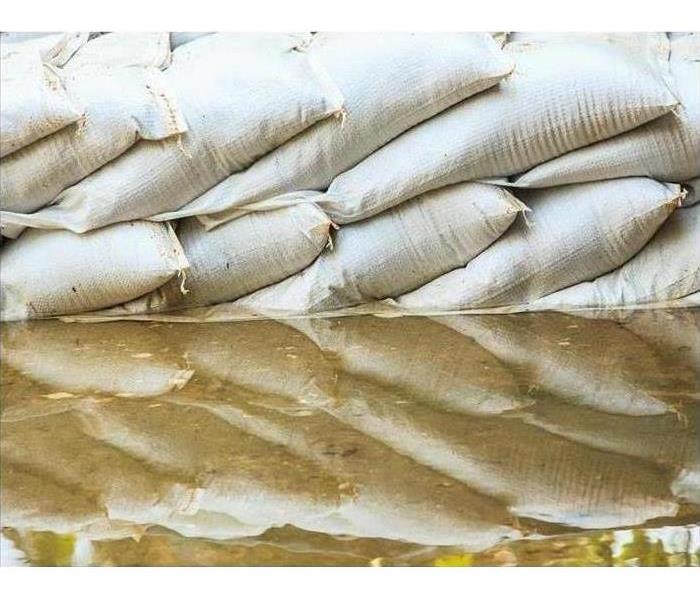 Flooding can cause devastating damage to your building.
Flooding can cause devastating damage to your building.
Ways To Keep Your Property Safe From a Flood
Water damage to buildings is a common concern for property owners in Woodland Hills, OK. Flooding can happen at any moment without warning and cause irreparable damage. Causes are varied and include:
- Improperly installed water supply lines
- Storms
- Sewage overflow
- Burst pipes
You can keep your building protected from a flood by taking preventative measures and maintaining your property. Here are a few ways to keep your property safe from a flood.
1. Pay Attention to Flood Warnings
Newscasters take care to warn citizens of oncoming flash floods and heavy downfalls. It is important to monitor the weather to have sufficient time for preparation. You can prepare your building for flooding by having sandbags ready, especially if floods are common in your area. When there are flood warnings in your area, stack the sandbags against your property like bricks. Move expensive electronics and furniture to higher ground if you are able.
2. Know Your Risk
Before you own a property, research the area to know the risk of floods. If they are common, design your building accordingly. There are companies that build flood-resistant buildings. You can hire a contractor to build your property above flood level. To flood-proof an existing building, you can raise electrical outlets and install flood-rated products. Preparing your building will lessen the risk of irreparable flood damage.
3. Know What is Covered by Your Insurance
Most insurance companies do not cover flood damage. If you are purchasing a property in an area with high risk, you will likely be required by law to have flood insurance. Shop the area for insurance companies that give you the best coverage at the best rate. Once you purchase your insurance plan, ask them for a list of providers. Keep yourself informed of the storm damage restoration services in your area by researching reviews and their specializations.
Flooding can cause devastating damage to properties in Woodland Hills, OK. You can prevent having to spend thousands on repairs by preparing your property accordingly.
Prepare your Property From the Risk of Flood
4/24/2023 (Permalink)
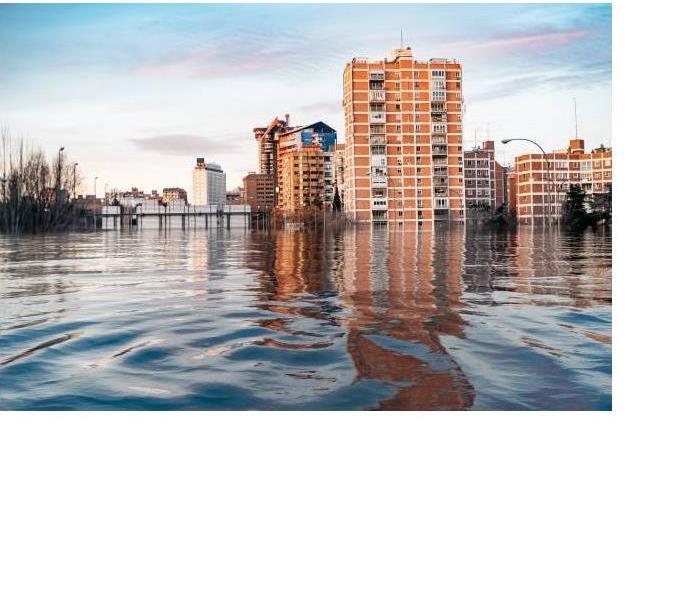 Floods can be devastating, preparing your property for such an event can save the property owner thousands on repairs.
Floods can be devastating, preparing your property for such an event can save the property owner thousands on repairs.
Water damage to buildings is a common concern for property owners in Oklahoma. Flooding can happen at any moment without warning and cause irreparable damage. Causes are varied and include:
- Improperly installed water supply lines
- Storms
- Sewage overflow
- Burst pipes
You can keep your building protected from a flood by taking preventative measures and maintaining your property. Here are a few ways to keep your property safe from a flood.
1. Pay Attention to Flood Warnings
Newscasters take care to warn citizens of oncoming flash floods and heavy downfalls. It is important to monitor the weather to have sufficient time for preparation. You can prepare your building for flooding by having sandbags ready, especially if floods are common in your area. When there are flood warnings in your area, stack the sandbags against your property like bricks. Move expensive electronics and furniture to higher ground if you are able.
2. Know Your Risk
Before you own a property, research the area to know the risk of floods. If they are common, design your building accordingly. There are companies that build flood-resistant buildings. You can hire a contractor to build your property above flood level. To flood-proof an existing building, you can raise electrical outlets and install flood-rated products. Preparing your building will lessen the risk of irreparable flood damage.
3. Know What is Covered by Your Insurance
Most insurance companies do not cover flood damage. If you are purchasing a property in an area with high risk, you will likely be required by law to have flood insurance. Shop the area for insurance companies that give you the best coverage at the best rate. Once you purchase your insurance plan, ask them for a list of providers. Keep yourself informed of the storm damage restoration services in your area by researching reviews and their specializations.
Flooding can cause devastating damage to properties OK. You can prevent having to spend thousands on repairs by preparing your property accordingly.
3 Post-Flood Mistakes All Homeowners Can Avoid
6/27/2022 (Permalink)
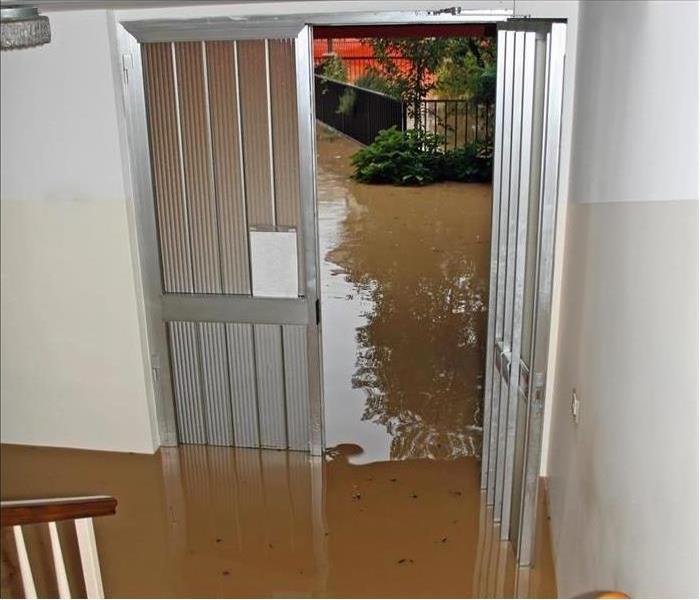 A flooded home in Woodland Hills, OK.
A flooded home in Woodland Hills, OK.
Flood Tips
After experiencing a residential flood in Woodland Hills, OK, many homeowners are anxious to begin the process of cleanup and repair. With flood water subsiding and insurance companies involved, it may be time to begin the restoration process. Before you jump into the job with both feet, be sure you are prepared for what is ahead. Stay safe and streamline the work that goes into repairing a home flood by using these three helpful tips.
1. Wear Proper Attire
Flood cleanup is a large process to tackle. As you begin the duty of drying and restoring your residence, don’t underestimate the importance of proper clothing. Exposure to contaminated liquid may be dangerous, and walking into a longstanding pool of water can pose several risks. Some essential clothing to consider during cleanup might include the following:
- Knee-high rubber boots
- Long-sleeved shirt and pants
- Disposable respirator mask
- Goggles
- Rubber gloves
2. Don’t Touch Standing Water
Following a large storm where flood water fills a home, many home residents impatiently await the time that they are allowed to go back into their property. While it may be tempting to walk around your flooded home to assess the damage, it is never a good idea to enter a house that’s taken in too much moisture. If downed power lines are in contact with standing water, the risk of electrocution is very high. For safety reasons, contact a licensed electrician to clear the area before getting started.
3. Follow Clean-Up Protocol
After taking in the severity of the water damage left behind by a residential flood, many homeowners want to speed up the sanitation process as much as possible. In order to achieve the best results, be sure to consult storm damage restoration specialists. Work closely with your property insurer and follow its processes. This will ensure more timely results and proper repairs.
Keep these tips in mind as you begin to rebuild after a residential flood. For a safe and efficient process, deal with flood water damages in a cautious and routine manner.
Learn About the Basics of Roof Damage Mitigation
6/19/2022 (Permalink)
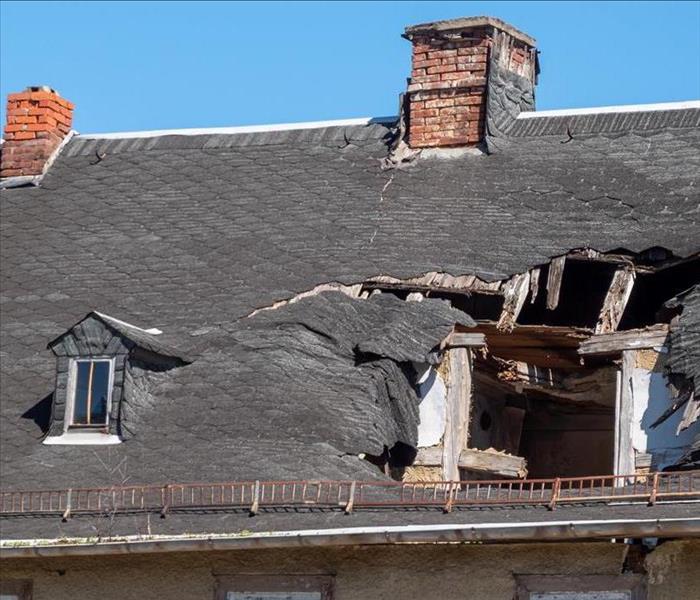 Roof damage in a home in Leonard, OK.
Roof damage in a home in Leonard, OK.
Roof Damage Mitigation
After a powerful storm, roof damage can leave your Leonard, OK, home vulnerable to other types of damage. When a residential restoration company arrives, one of the first actions it should take is to enact mitigation on your damaged rooftop. Learn more about the purpose of this process, its execution and the steps taken afterward.
Definition and Purpose
Whenever you hear about damage mitigation in any restoration case, you should know it simply means an attempt at preventing the damage from getting worse. The team's repair investigation might take some time, so they will need to protect your home from threats such as:
- Trespassers
- Wild animals
- Strong weather
- Deterioration
The mitigation either prevents these potential issues or delays them until the workers are ready to fix your house. It is meant to be a short-term solution that assists the long-term repair plan.
Roof Damage Mitigation Process
Upon their arrival, the restoration experts will evaluate the area for any hazards and attempt to neutralize them. Afterward, they can investigate the extent of the wind damage and determine the tools and materials needed for mitigation. The debris in the area is removed to facilitate the process. Once the technicians take the proper measures, they can board up and install tarps on any existing openings and weak points throughout your home.
Aftermath of Mitigation
Once the mitigation procedure is complete, the specialists will inspect the rest of the property and formulate a plan for the entire property. Specifically, they will look at the interior components and any belongings you have kept inside. Since the interior is already protected by the boards and tarps, it will be easier to take the time to create a plan to restore as much as possible with the best resources. These additions will then be replaced by a more permanent repair.
An intense storm can result in various forms of destruction, including roof damage. Ensure that your remediation team performs damage mitigation on the roof to protect your Leonard, OK, home during the process.
3 Key Things Your Business Needs Before a Storm Arrives
4/25/2022 (Permalink)
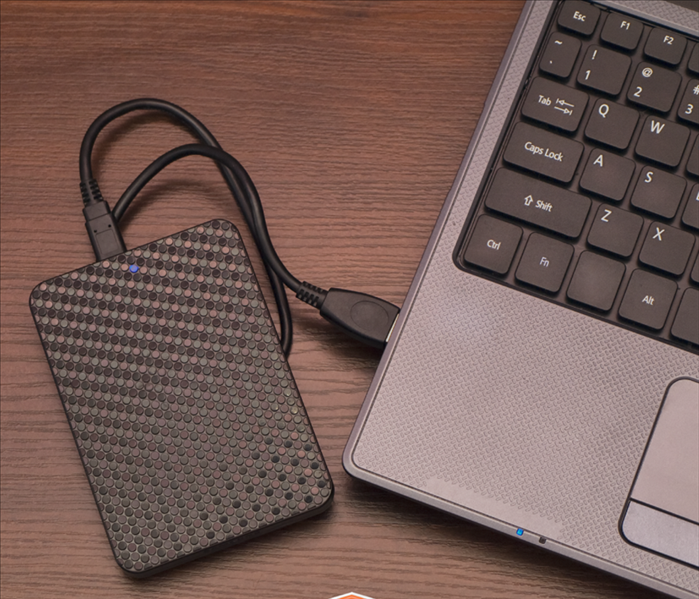 Keep computer files backed up on an external hard drive or cloud in case of an emergency.
Keep computer files backed up on an external hard drive or cloud in case of an emergency.
Prepare Your Business Before a Storm Arrives
If your company in Jenks, OK is heading into a stormy season, now is the time to prepare for potential impacts on your business. Don't wait until your local forecast includes rain, damaging winds, or even a more serious weather event. Start developing corporate emergency plans now that address your assets as well as property and flood insurance policies.
Create a Disaster Plan
Every business, no matter how big or small, needs a disaster plan to ensure it minimizes downtime and losses in the event of an emergency situation. Plans should be reviewed every year to update for changes in management and staffing, office locations, individual and commercial insurance carriers, and local or regional government issues.
Your plan should include the following:
- Primary and alternate work locations for all departments
- Backup and recovery of data and systems
- Vehicle and asset lists for all your locations
- Employee contact information
Anticipate Damage
If a weather event is a forecast and your office is located in an area under a state of emergency, planning for potential damage is essential to successfully minimizing the impact on your business. Develop a list of construction companies, storm damage restoration services, and other contractors to help with cleanup and rebuilding after the storm. Review the list annually to ensure you have up-to-date contact information.
Get Covered Early
Most carriers require a 30-day wait period before a newly purchased policy goes into effect. Some insurance companies also stop issuing new policies in regions under the threat of adverse weather events. To ensure your company is covered well in advance of a natural disaster, compare quotes for property and flood insurance policies long before you may actually need them, and select the best coverage early.
Identify what you have, who will fix it, and where to get property and flood insurance. Planning is the key to successfully surviving a season of storms.
Preparing Your Business for a Flood
4/6/2022 (Permalink)
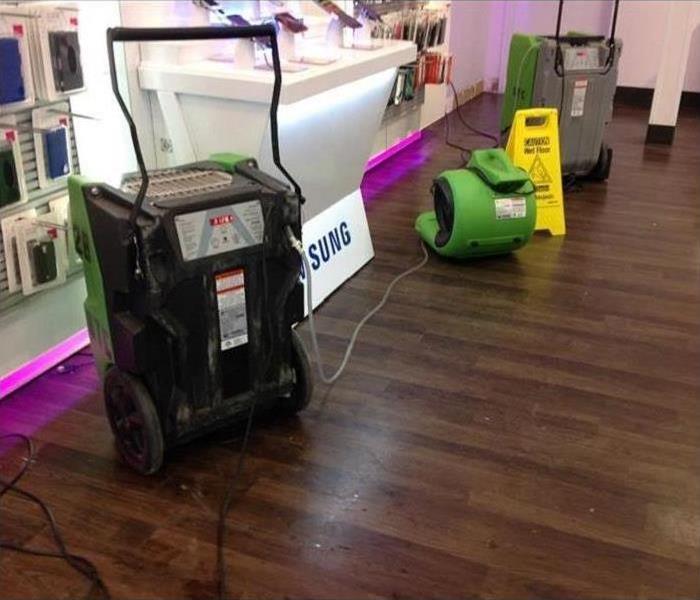 Storm cleanup in a store in Burning Tree, OK.
Storm cleanup in a store in Burning Tree, OK.
Flood Preparedness for Your Business
Preparing your business for a flood is more than just preparing a sand bag barrier and hoping for the best. It takes some time and planning, but there are a few simple steps.
Create a Plan
When it floods, you need a plan. This includes:
- Getting insurance
- Training your employees
- Checking your business flood zone
- Noting areas that may need flood dams
- Duplicating critical information and storing it at another location
Make sure you write down your plan and keep it in an area where you and your employees can find it in the event of a flood. You should also keep the number of a flood remediation company handy just in case.
Check Your Cities Flood Plan
You should know what Burning Tree, OK, does in the event of a flood. Some cities offer flood supplies when a storm is imminent, while others have pumps that are turned on when floodwaters threaten businesses. Other cities open areas where sand bag devices or other flood barriers can be purchased and filled.
Purchase Supplies
Do not wait until the last minute to purchase supplies like barriers, heavy tape, tarps, boards and barriers. There are usually shortages of these items right before a flood. If you keep these items in storage, check them before storm season to ensure they are still in working order. These items can easily prevent flood damage to your business, and it is better to have them just in case.
Outline What Happens After a Flood
Having an outline for what happens after a flood is just as important as planning for the flood itself. You should know what you need to do, who you need to call and what precautions you need to take. Just having this can help you remain calm and reduce the stress of dealing with water damage.
Preparing for a flood is more than just throwing a sand bag or barrier device down. Having a clear idea of what you need to do before and after can help you keep your business safe from flooding.
3 Solutions for Ice Dams
1/11/2022 (Permalink)
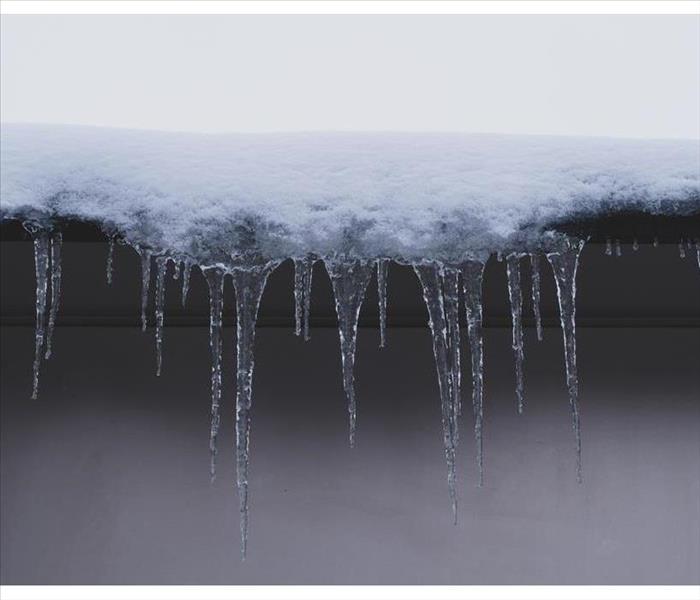 You can prevent an ice dam from wreaking havoc on your home.
You can prevent an ice dam from wreaking havoc on your home.
Winter Storms Disasters
The winter season in Broken Arrow, OK, usually consists of snow, ice, and heated housing. The combination of these elements can create an ice dam on your roof that prevents proper drainage and creates bigger issues for you. Sometimes heat isn’t distributed evenly to your roof and can warm certain areas while leaving other areas to freeze. To prevent water damage and fix any winter storm disasters, here are three solutions you can use.
1. Insulate Your Roof
The best ice dam prevention solution is to properly insulate your roof. Heat escapes through ceilings and rises to the roof where it warms the wood and shingles above. To prevent this, check the depth of your insulation. Anything less than 8 inches is usually not enough to prevent heat from escaping. You can also stop air leaks by using foam or caulk. This will not only stop roof issues, but it will also save you money on your energy bill.
2. Remove the Buildup
If you notice a large amount of snow gathering on your roof, you might want to consider eliminating it. Houses that have poor ventilation can also have poor distribution of heat. By removing the snow with a push broom or shovel, you can clear any potential problem areas.
3. Create Channels in the Ice
Ice dams that are already formed can force the water to enter the house through the attic. You can stop this by creating channels in the ice and draining the water into the gutters. Use a hose with warm water and melt the lower edge of the ridge. This solution is a temporary fix but could prevent a large amount of winter storm damage.
Winter can have many unique challenges, but you can stop problems from growing by being an observant and proactive homeowner. With these methods in mind, you can prevent an ice dam from wreaking havoc on your home.
Top Items To Include in Your First Aid Set
11/15/2021 (Permalink)
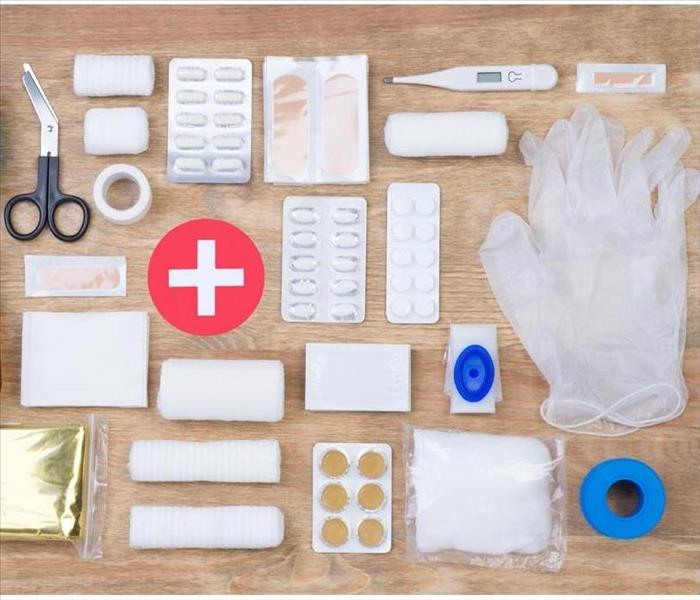 Make sure you have all the supplies you need in your first aid kit.
Make sure you have all the supplies you need in your first aid kit.
First Aid Kit
When you build a first aid kit for your commercial property in Glenpool, OK, you want to make sure it is complete. There are some obvious items you have to have in this kit, but others may surprise you. Check out this quick guide to build the best kit possible.
1. First Aid Guide: Because this kit could be used by a wide range of people, you need to have a basic guide for first aid included. This guide may go over how to clean minor cuts or use resuscitation equipment.
2. Blankets: Blankets can serve a lot of purposes, such as keeping someone warm or being used as a sling. Because you don't know what type of emergency will require the use of a first aid kit, it is best to stock it for any type of situation.
3. Bandages: Many people turn to an emergency kit when there is a cut, scrape or burn. Various sized bandages and gauze pads can help stop bleeding and protect open wounds.
4. Sterile Gloves: Handling someone else's blood can be unsanitary work. Including gloves in the set makes it easier for care to be given to those who need it.
5. Resuscitation Equipment: A pocket mask and guide to CPR can help equip a person for an emergency situation.
6. Automated External Defibrillator: This portable device can be used to shock someone undergoing cardiac arrest. Many AEDs also walk those using the device through the procedure to ensure everything is done correctly.
7. Emergency Directions: Who needs to be called when there is an emergency? These directions could list your phone number or the number of your commercial property repair team.
As a commercial building owner, you need to do whatever you can to keep those inside your property safe. Putting together a complete first aid kit can provide the tools needed to survive an emergency.
The Process of Making a Flood Cut
9/6/2021 (Permalink)
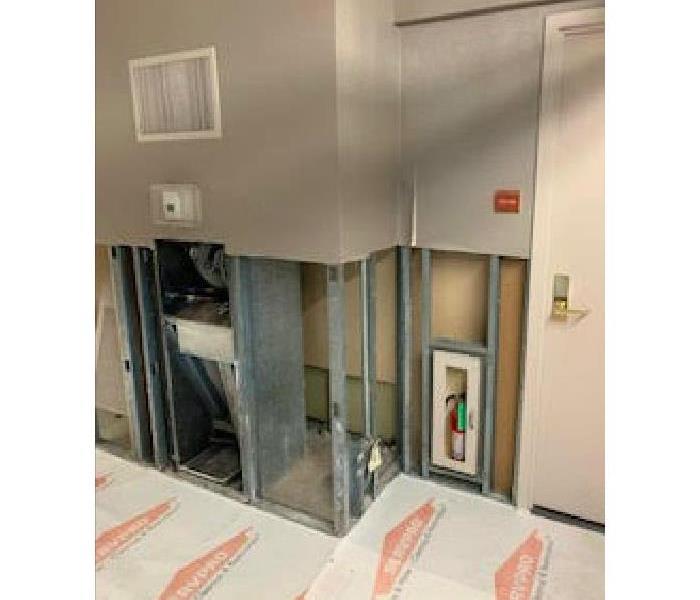 If you have flooding in your home, you may need a flood cut to mark the spot where the wall gets removed.
If you have flooding in your home, you may need a flood cut to mark the spot where the wall gets removed.
Flooding often leads to water damage, and water damage often leads to the removal of affected items and structures. If your home in Broken Arrow, OK, floods during a storm, mitigation experts may have to use a flood cut to determine how much of your wall to tear out. A flood cut is a mark that is made 12-18 inches above the perceivable water damage to a wall to mark the point to which the technicians need to remove the drywall. Here are the steps of using a flood cut.
1. Determine Necessity
A flood cut is not always necessary. If water damage is minimal or the water is clean, the wall probably doesn't need to be removed. When the flooding is the result of a storm, however, the contamination of the water seeps into the walls. It's best, therefore, to mark them with a flood cut and remove the walls, especially if they are saturated.
2. Prepare for Mess
Removing the drywall is usually a pretty messy process. You will probably see the professionals put a tarp down before they begin. It's also advisable for them to wear gloves and protective clothing, especially if they will be removing damp insulation that's behind the wall.
3. Remove Wall
Once there is a tarp down to catch the falling drywall, the demolition process can begin. Technicians start at the flood cut and remove everything below it, ensuring that all the water damage is gone.
4. Clean the Mess
The wall that they tear out has to go somewhere. Another benefit of using the tarp is that it makes for easy cleanup. They can just gather the edges to contain the mess and head to the dumpster.
5. Replace Wall
Many mitigation professionals are also restoration experts. They can put new insulation and a new wall back up and blend the paint so that it looks "Like it never even happened."
If you have flooding in your home, you may need a flood cut to mark the spot where the wall gets removed. Understanding the steps of the process can help you know what's going on when the professionals arrive.
An Explanation of Black Water and Its Effects
7/29/2021 (Permalink)
 Overflowing toilet
Overflowing toilet
Black Water and Its Consequences
Any type of flooding can be dangerous and can cause widespread damage to your property and home. It’s important to protect yourself and those things you value most so that when water damage does occur at home, it’s as minimal as possible. The worst situation you can find when flooding occurs is black water. If you find this making its way into your Burning Tree, OK, home, you must exercise extreme caution and place appropriate safeguards to ensure your safety.
What Is it?
While any type of water that invades your home is a concern, black water poses serious health concerns to you and your loved ones. This type of water mixes with raw sewage, including your toilet water. It can make you ill if you come in contact with it. This type of floodwater can even cause serious bodily harm if you ingest it. Here’s why it’s so hazardous:
- Contains feces from septic systems, toilets and sewers
- Contains urine
- Contains other dangerous materials such as bacteria
How it Gets in Your Home
Water damage can ruin furniture, walls, flooring and even treasured keepsakes such as books, pictures and trinkets. However, water mixed with sewage can be destructive. When heavy storms overwhelm storm drains and get into sewage, they can infiltrate homes and other buildings. This type of water can also be a problem if you have plumbing issues, and your toilets overflow, or your pipes break.
The Solutions
While this type of flooding should alarm anyone, you can combat it and take appropriate measures. First, if you notice this flood type of water, avoid it at all costs. Get to a safe place, and ensure your children don’t come in contact with it. You should then call a disaster cleanup company and public works official to address the matter.
You worry about water damage anytime there’s flooding. Black water is an even bigger problem, so it’s vital that you take the right steps to remedy this situation.
3 Ways to Keep Your Property Safe From a Flood
5/26/2021 (Permalink)
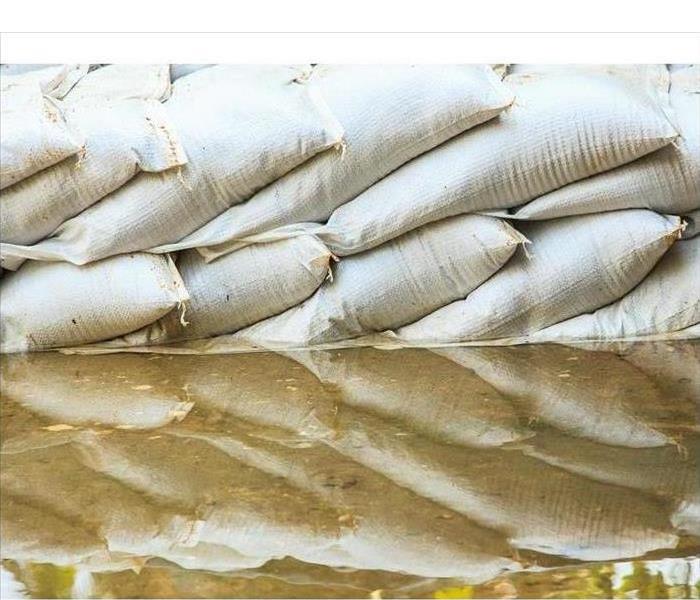 Flooding can cause devastating damage to your building.
Flooding can cause devastating damage to your building.
Ways To Keep Your Property Safe From a Flood
Water damage to buildings is a common concern for property owners in Woodland Hills, OK. Flooding can happen at any moment without warning and cause irreparable damage. Causes are varied and include:
- Improperly installed water supply lines
- Storms
- Sewage overflow
- Burst pipes
You can keep your building protected from a flood by taking preventative measures and maintaining your property. Here are a few ways to keep your property safe from a flood.
1. Pay Attention to Flood Warnings
Newscasters take care to warn citizens of oncoming flash floods and heavy downfalls. It is important to monitor the weather to have sufficient time for preparation. You can prepare your building for flooding by having sandbags ready, especially if floods are common in your area. When there are flood warnings in your area, stack the sandbags against your property like bricks. Move expensive electronics and furniture to higher ground if you are able.
2. Know Your Risk
Before you own a property, research the area to know the risk of floods. If they are common, design your building accordingly. There are companies that build flood-resistant buildings. You can hire a contractor to build your property above flood level. To flood-proof an existing building, you can raise electrical outlets and install flood-rated products. Preparing your building will lessen the risk of irreparable flood damage.
3. Know What is Covered by Your Insurance
Most insurance companies do not cover flood damage. If you are purchasing a property in an area with high risk, you will likely be required by law to have flood insurance. Shop the area for insurance companies that give you the best coverage at the best rate. Once you purchase your insurance plan, ask them for a list of providers. Keep yourself informed of the storm damage restoration services in your area by researching reviews and their specializations.
Flooding can cause devastating damage to properties in Woodland Hills, OK. You can prevent having to spend thousands on repairs by preparing your property accordingly.
What Is and Is Not Covered By an NFIP Policy
4/10/2021 (Permalink)
Make Sure You Have The Following When Purchasing This Type Of Policy
When you are purchasing commercial insurance through the National Flood Insurance Program, it is important to know what it does and does not cover. Here are a few things that you make sure that you have when you purchase this type of policy.
Building Coverage
Building coverage protects:
- Electrical, fuel, air conditioning and plumbing systems
- Appliances
- Cabinets, carpet, bookcases and filing cabinets that are permanently installed
- Detached garages
Essentially it covers any property that is permanently affixed to your business and most major systems. This type of commercial insurance coverage might also cover flood remediation in Tulsa, OK, or wherever your business is located.
Property or Contents Coverage
This coverage protects the contents of your building. It will cover personal property, curtains, portable air conditioning units and other valuable items. Your flood policy may also cover inventory and other items that belong to your business, depending on how it is written. If you have inventory, check with your underwriter to make sure it is covered.
What It Does Not Cover
The National Flood Insurance Program does not cover properties that are not affected by a flood under its definition. The FEMA definition of a flood under this program is an excess of water on at least two acres of land or affecting two or more properties. For instance, if you are flooded by a broken pipe or your toilet backs up and floods, you will not be covered under this program.
This type of insurance also does not cover financial losses from a business interruption, vehicles and valuable papers. You want to make sure that you have offsite copies of valuable papers in case of a flood or fire.
When you are purchasing a National Flood Insurance Protection policy, it is extremely important to make sure that you know precisely what is and is not covered. If you are worried about specific contents or other types of flooding, you might need to check into purchasing an additional commercial insurance policy.
3 Ways to Respond a Canceled Flight
1/14/2021 (Permalink)
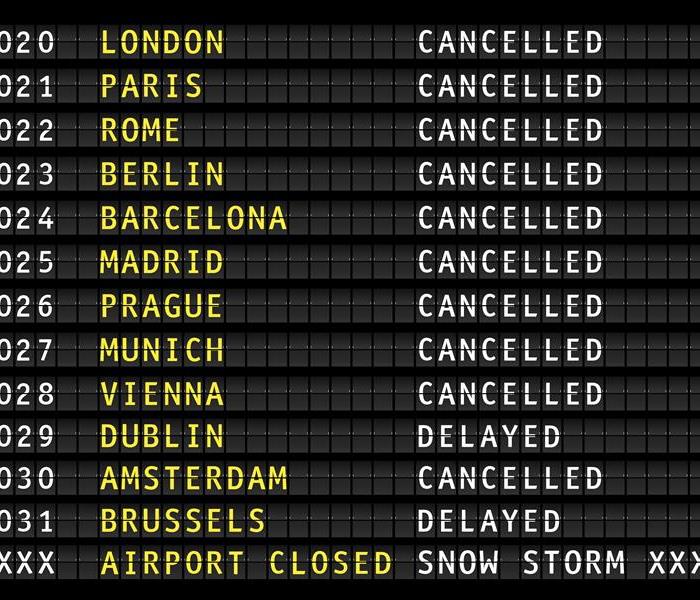 A canceled flight can be a disappointing experience
A canceled flight can be a disappointing experience
Here Are Some Ways You Can Handle The Cancellation
What happens when you receive a canceled flight notification because of a storm in Burning Tree, OK? Depending on your situation, you may have a few options. No matter what, there will probably be some waiting involved, so it can be a good idea to make the best of your time. Here are some ways you can handle the cancellation:
1. Wait for the Next Available Flight
If your trip is long enough to justify the wait time for the next available flight, then maybe waiting around the airport is the right option. Find out how many flights are going between your current location and your destination. If there are many routes available, there is a higher chance another flight will be available soon. Keep an eye on the local weather report and listen to storm tips to stay informed.
2. Go Home and Reschedule
This option has the longest wait. Although it might be less fun, you could always cancel your trip and reschedule for another time. If the storm that caused the canceled flight is in your area, being home could be a good idea. There, you can keep an eye on your house and be available in case you need the help of a storm damage remediation professional if the weather gets severe.
3. Go Somewhere Else
How adventurous are you feeling? Depending on the flexibility of the airline, a third option you have is to book a flight somewhere else entirely. If you have very specific plans for your trip such as seeing Grandma or Disneyland, this probably will not be the best idea; however, if you are flying solo for a trip with less commitment, going somewhere random and unexpected could be the adventure of a lifetime.
When you are ready to go on a trip, a canceled flight can be a disappointing experience, and it can lead to confusion about what to do next. Depending on your situation, you have some different options to choose from. Follow local weather advice and do what works best for you.
Flooding: 5 Alternatives to the Sand Bag
11/16/2020 (Permalink)
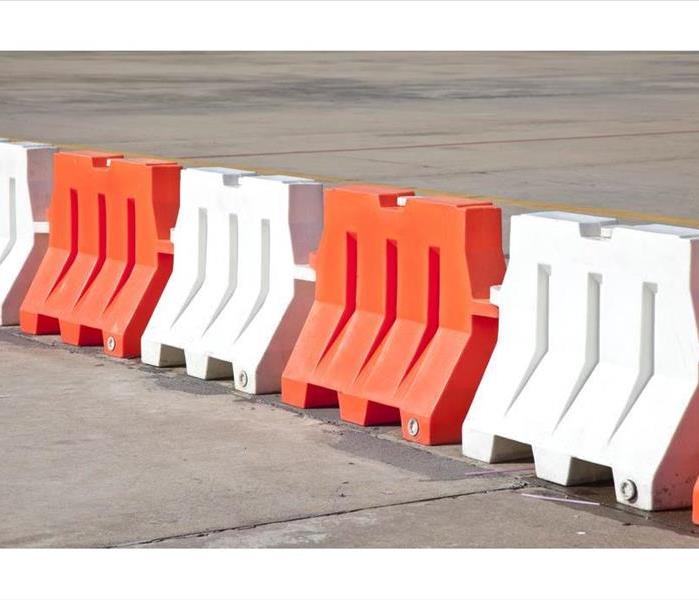 Plastic barriers
Plastic barriers
List Of Options In The Market
If your business is located in a flood zone, flooding and flood damage are a constant threat to your property. Until recently, the flood prevention standby was the tried-and-true, pre-filled sand bag. It's both inexpensive and widely available. However, as anyone who's tried to lift one knows, at over 28 pounds, it's weighty, unwieldy and labor-intensive. After a flood, the accumulated dirt, bacteria, sewage and other environmental contaminants require its disposal at a designated hazardous materials site.
Today, there are more effective and less polluting alternatives to create protective flood dams around your property. Here's a short list of options now on the market:
- Transportable Flood Fence Barriers: Best used before a storm, these moveable, multi-sized tubing chains allow water to flow inside. They can be arranged into a defensive perimeter (large or small) around your property to safely fence it from floodwaters.
- Plastic Poly Tube Flood Barrier: Based on the same concept as a sand bag, these easy to use large tubes can be filled with many substances, most commonly dirt. Once filled, they're long, high and effective.
- Inflatable Dam: By placing the uninflated dam around your property and (with a hose) filling it with water, you're able to construct a stable, tall flood barrier. It's designed to keep even high floodwaters out.
- HydraBarrier: Manufactured with thick vinyl, each barrier is 6-feet long by 10-inches wide by 6-inches high and can be placed wherever needed. One HydraBarrier equals 4 sand bags.
- NoFloods Barriers: This very large, inflatable dam is lightweight, flexible and adaptable to your property's configuration. Filled with air and water, this option was successfully tested in 2014 during severe flooding in Europe.
Many disposal and non-disposable sand bag alternatives are on the market to suit the needs of smaller business properties in Bixby, OK. Stormbags, flood bags, Absorbeez, Sorbarix, FloodSax, Hydrosack and Aqua-Sac are state-of-the-art variations that are super-absorbent, lightweight and easy to place at vulnerable locations, such as doorways. It's worth taking a look at the available high-tech products that give business owners new, improved ways of protecting their property from ruinous flooding.
5 Ways to Prepare for a Flood
10/21/2020 (Permalink)
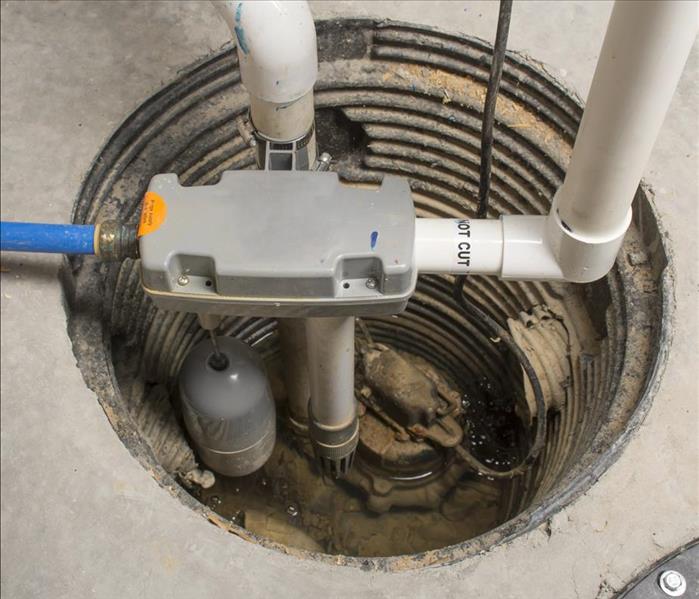 Install and maintain your sump pump
Install and maintain your sump pump
Flood Safety Should Always Be Taken Seriously
Storm season can wreck havoc on your residential home. Preparing to face a storm or flood ahead of time is the key to reducing the amount of damage your home in Woodland Hills, OK, has to endure. Implement the following flood safety advice the next time you need to prepare for a severe storm.
1. Sign Up for Flood Alerts.
You can't prepare for disaster if you don't know that it's coming. Keeping your eyes and ears open for danger is the golden rule of flood safety. There are several local and national alert systems that you can sign up for to keep you in the loop.
2. Install and Maintain Your Sump Pump.
A sump pump is a device that's used to prevent flooding by collecting and redirecting excess ground water. Installing one of these devices can be extremely handy, but you also have to make sure that you're taking good care of it.
3. Elevate Electrical Devices.
It's recommended that all electrical components, including switch boards, circuit breakers, wiring and more, remain elevated at least one foot above the projected flood level. Flood water can fry and destroy electronic devices, as well as enhance the danger in your home by electrifying standing flood water.
4. Waterproof and Relocate Valuables.
All valuable possessions, such as important documents, family heirlooms and portable electronic devices need to be sealed in waterproof containers and relocated to high shelves on the top flood of your house.
5. Build an Emergency Supply Kit.
Severe floods can leave your household stranded for hours, and sometimes even days. Stocking an adequate emergency supply kit could potentially save your life. Suggested items to pack include, but are not limited to, a flashlight, extra batteries, bandages, gauze, non-perishable food items and plenty of fresh water.
Flood safety should always be taken seriously. While the above safety tips can certainly help reduce the amount of damage that your home endures, they won't guarantee your complete protection. Contact flood remediation experts if your home has recently suffered any type of water damage.
What Is Roof Damage Mitigation?
9/24/2020 (Permalink)
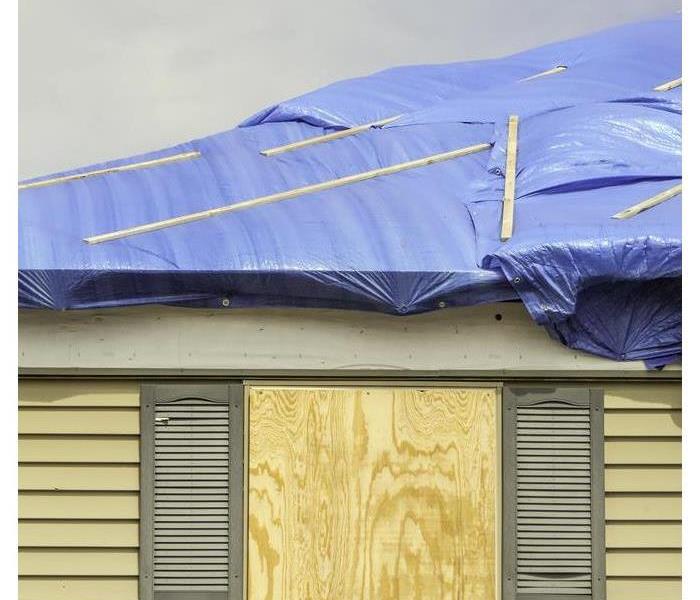 If you don't have a large tarp, it would be a good idea to have one before the next big storm.
If you don't have a large tarp, it would be a good idea to have one before the next big storm.
Seasonal storms in Bixby, OK, always bring the risk of damage. Even if a storm causes minor damage to your home, if that minor damage is ignored, it could become bigger damage. Roof damage needs to be mitigated as soon as it is identified. This means protecting the damage from becoming worse as it is repaired.
Roof Inspections
After any big weather event, you should have your roof inspected for damage or potential future problems. Often times you can't see roof damage from the ground, and if you can't see it, it has the potential to become worse even from less severe storms.
If you know others in our area have experienced wind damage, it's quite possible your home also experienced damage. You never want the rain to enter your roofing system and reach your insulation, because then you may need a whole new roof.
Just because hail isn't large doesn't mean it can't cause damage. A lot of factors play into hails potential to cause damage to your roof, including wind speed and the velocity at which the hail fell. If you have large hail and high winds, you can almost be sure there is damage.
It's never a good idea to wait until the next rainfall to find out if the hail caused damage. You're putting the structural integrity of your entire home at risk.
Mitigation Techniques
If you know your roof has experienced damage, you can use boards and tarps to protect it until a restoration company is available. If you can't tarp your roof, use buckets to catch rain and prevent water from causing even more damage.
It's likely others in your vicinity experienced damage as well, but professionals will be working to get to your home as quickly as possible. Your goal during mitigation is to prevent further damage.
While nobody ever wants to experience roof damage, it should always be something you're prepared for. If you don't have a large tarp, it would be a good idea to have one before the next big storm.
How Your Company Can Survive a Hurricane
9/14/2020 (Permalink)
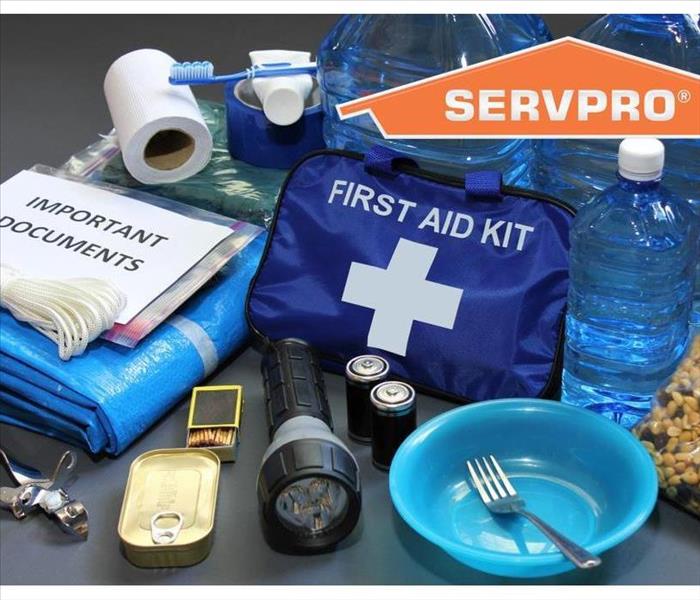 What important documents should you have for an emergency?
What important documents should you have for an emergency?
How To Mitigate Hurricane Damage To Your Building
Hurricane damage does not just affect your house. Your business could be harmed by this type of storm, as well.
If you are not properly prepared, your Bixby, OK, company might close for good. In fact, 40 percent of small businesses that shut down due to a hurricane never reopen. To keep your company on the right side of this statistic, you should follow the below steps.
1. Store Emergency Items
Designate one part of your building as the emergency equipment area. The location should include everything you and your employees will need once the storm hits. Be sure to have three-day supplies of food and water for all of your workers. You should also store batteries, flashlights, and a small radio or television.
Your emergency supplies should additionally include a tool kit and First Aid equipment. Keep cots, pillows, and blankets on hand, as well, in case you or your employees have to take shelter in the building.
Finally, post the contact information for the nearest police station and hospital. This way, your workers will be able to get emergency help if they need it. Employees should also know the phone number for your local hurricane damage restoration company.
2. Protect the Property
High winds from a hurricane may cause nearby trees to fall. You should thus make sure any branches close to the property are trimmed ahead of the storm. You may also want to secure any electronics or large furniture with straps or braces. Consider installing plywood or shutters onto the windows, as well.
3. Secure Documents
While most of your business is probably conducted online, you likely still have important paperwork in your office, including tax documents and legal contracts. These items should be sealed in waterproof containers and stored in an off-site location.
The above tips should help you mitigate the hurricane damage to your building. If you prepare ahead of time, you can increase your company's odds of surviving the impending storm.
Tips on Safely Dealing With Flooding
8/13/2020 (Permalink)
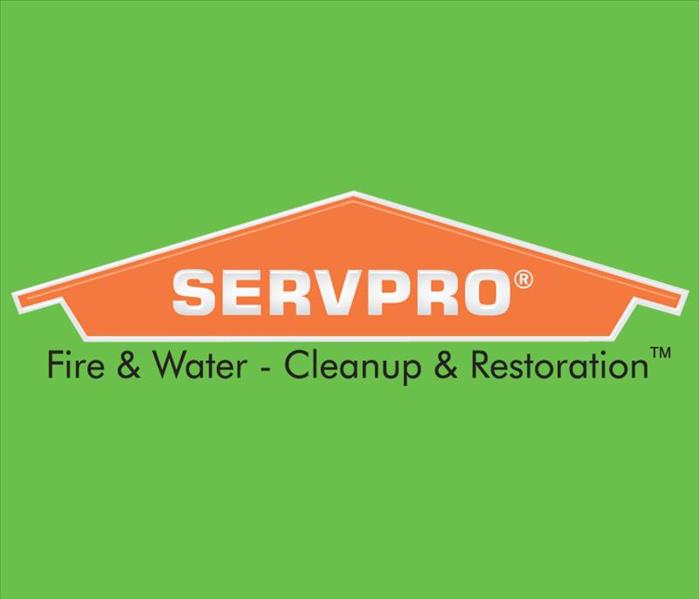 o help speed up the drying process, turn on your air conditioning unit.
o help speed up the drying process, turn on your air conditioning unit.
If your home has sustained water damage due to flooding, there are many critical items to consider. Flood safety is your number one priority. If the flooding is extensive, your family and pets should leave the house immediately and call a storm damage restoration service. If the water is contained in a small area, you may be able to stay in your home until the restoration service arrives. In that case, there are several safety tips you should begin implementing right away.
How To Safely Remove Water From Your Home
Follow flood safety recommendations by turning off the electricity in the area that is affected. Put on rubber gloves to protect your hands as well.
Remove the water - If the flooring is a hard surface, such as linoleum, tile or cement, mop up the water and then wipe the entire surface with a dry towel. If you have carpeting, blot the wet area with clean rags or towels. Continue blotting until you have removed as much water as possible.
Move the furniture - Any moveable furniture and belongings that are located in the water-damaged area should be moved to a safe location and blotted or wiped dry. If the items are destroyed, throw them out right away. Call your local trash pickup service to make sure they will take the items. Otherwise, the restoration service will dispose of them when they arrive. Large items, such as sofas or beds, that can't be moved easily can be propped up on wood blocks. If you don't have any wood available, put sheets of aluminum foil under the legs.
Turn on the air conditioning - To help speed up the drying process, turn on your air conditioning unit. In very humid areas, such as basements, a dehumidifier is a great idea as well.
It is traumatic to deal with flooding in your home in Glenpool, OK. If you follow some flood safety guidelines, however, it will help get things back in order much quicker.
How To Maintain an Effective Sump Pump
8/11/2020 (Permalink)
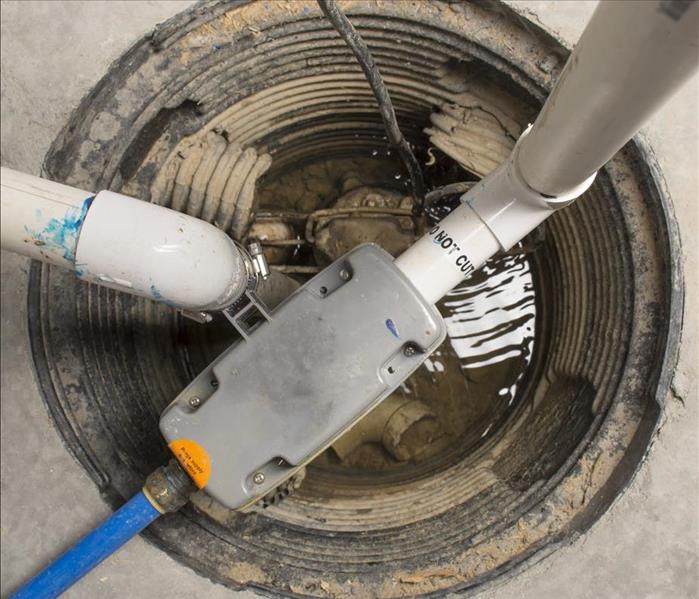 Keep your sump pump running smoothly all year long
Keep your sump pump running smoothly all year long
Annual and Quarterly Maintenance Tips
A sump pump is probably not something you think about very often. If it doesn't work when you need it, however, it comes to the forefront of your thoughts pretty quickly. To keep your pump running effectively in your home in Burning Tree, OK, it's important to conduct pump maintenance on a routine basis. Listed below are some annual and quarterly maintenance tips to follow.
1. Annual Maintenance
Make sure your unit is plugged into a power source that connects to a ground fault circuit interrupter (GFCI). Ensure that the cord is not frayed or damaged. The pump must be level and upright in order to run properly.
It's important to note that before you begin any additional maintenance on your pump, you must make sure it is disconnected from the power supply.
Inspect the discharge pipe, the vent hole and the intake screen for debris, such as dirt and gravel, and remove it.
Make sure the drainage pipe is tightened securely and points away from the foundation of your home.
Check the pit and remove any debris. Also, make sure that there is no obstruction around the float component.
Once you have inspected the sump pump and removed all the debris, reconnect it to the power source. Then fill the basin with water. This should cause the pump to start draining the water immediately. If it doesn't, call a maintenance person as soon as possible.
If you have a pump with a battery backup, replace the battery per the manufacturer's instructions.
2. Quarterly Maintenance
In addition to the annual inspection, many experts recommend that you conduct some quarterly cleaning as well. Locate the pump's screen and clean it with a soft cloth. Some models have an inlet opening rather than a screen. This can be cleaned gently with a soft cloth as well.
Keep your sump pump running smoothly all year long by following these maintenance tips. If your pump begins to overflow, contact a water damage repair person right away.
Flood Protection: Beyond Sand Bags
7/8/2020 (Permalink)
Check Out These Other Options to Prevent Flood Damage in Your Commercial Property
The sand bag is a commonly recognized solution for preventing flood damage, but it isn't the only option available when it comes to keeping your Tulsa, OK, commercial property safe from storms and high water. Take a closer look at some of the other options.
DIY Levees
If you have enough advance warning, you could use the following steps from the U.S. Army Corps of Engineers to build flood dams around your property.
- Gather wheelbarrows, sheets of polyethylene plastic, a sand bag collection, shovels, and protective gear.
- Select a site with the right terrain and appropriate earth.
- Dig a 1- to 2-foot trench where you want the levee.
- Build up a mound with the soil, sand, or clay you have available.
- Cover the structure with plastic tarps.
Get more information about this method from local flood damage remediation professionals.
Inflatable Barriers
Filling sturdy bags with sand and then building a barrier around your property is a common method of directing flood waters away from your buildings and land. This method has been used to prevent flood damage for many years. The use of inflatable barriers follows the same principle except that the bags are filled with water instead of sand. The benefit is that filling the bags with water is much faster than using sand, and the time savings could prevent expensive losses.
Landscape Changes
Simple changes, such as grading landscaping away from your building, can help you avoid high water damages. Other tips include using native plants, grassy areas, water reservoir features, and rain gardens to divert extra rainfall or snow runoff. Drainage areas are also effective barriers.
Foundation Vents
Foundation vents are often used to circulate air under the floor during the summer to reduce moisture buildup. Don't confuse these vents with crawlspace vents. Flood vents, gates, or ports are used to reduce structural damage by allowing water to pass beneath a building.
As you gear up for the possibility of flooding, use more than a sand bag collection. Try out one or two of these alternatives.
When Does a Sump Pump Require Maintenance?
4/28/2020 (Permalink)
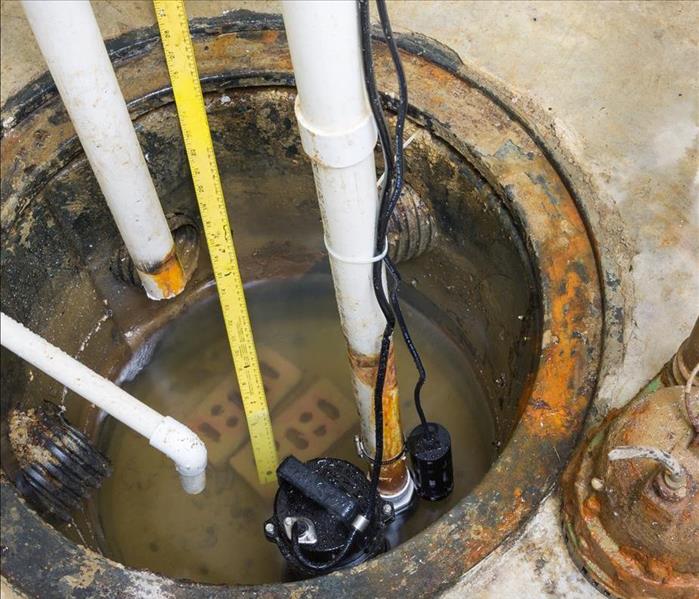 Sump pump in an Arrow, OK home
Sump pump in an Arrow, OK home
Reasons a Pump Might Require Maintenance
Homeowners depend on sump pumps to eliminate water from the lowest level of residences in Broken Arrow, OK. If a sump pump fails to function for any reason, a basement or crawlspace may fill up with water and result in water damage. Here are several reasons a pump might require maintenance.
Clogged Components
Some of the most common pump maintenance tasks involve cleaning out critical components. Debris such as dirt, rocks or roots or even a frozen blockage can limit the functionality of the following components:
- Intake screen
- Discharge pipe
- Pit
- Vents
Check the condition of parts where buildup tends to form. The float should also rise and fall with water levels. Homeowners can run a vinegar solution through the pump and clear out these components, including any grates and the air relief hole in the discharge line.
Installation Issues
The quality of a sump pump installation often determines the efficacy of this flood prevention equipment. A pump should never be set up in gravel or dirt, as these substances will end up blocking essential components. The discharge line should also have a check valve to prevent back flow and an air relief hole to vent pressure.
Pump Burn-Out
Components on a pump that is overworked with insufficient power may burn out. Make sure to choose the right size of pump for a particular application. If you are not sure which pump is the right choice for a basement, plan to have experts install this flood prevention equipment. This expense is considerably less than water damage restoration.
A sump pump might require cleaning or service for any of these reasons. If none of these issues are present and a pump is still not working, it may be faulty or power might not be available. A backup power source elevated above the flood level can help to ensure a pump functions properly.
5 Steps to Eradicate Lingering Water Damage Odors
4/3/2020 (Permalink)
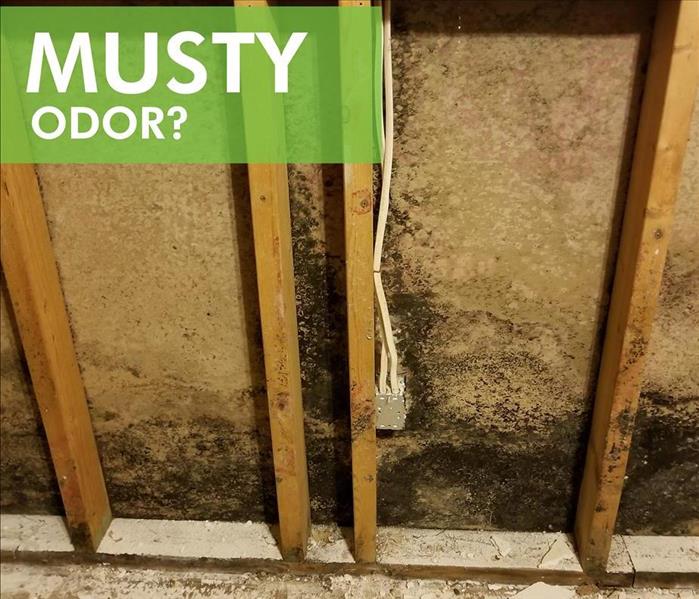 A strong, musty odor may indicate hidden mold behind drywall
A strong, musty odor may indicate hidden mold behind drywall
Below Are 5 Key Components To Eliminate The Problem
For businesses in Woodland Hills, OK, even a little water damage can quickly lead to mold growth and persistent odors that can be frustrating. If flood water is the culprit, it means other contaminants, such as sewage, have made their way into the building. When a lingering odor persists, a water remediation and water restoration professional can get your business back to normal. Below are five key components to eliminate the problem.
1. Find the Source
While sometimes the problem is obvious sewage loss, such as an overflowing toilet, oftentimes, there is hidden damage. The first hint of a musty odor means mold is growing somewhere. If there hasn’t been an obvious water issue, check dark, damp locations prone to extra moisture as well as porous materials, such as drywall, wood, and carpet. Inspect pipes, appliances, roofs, and foundation for signs of damage.
2. Repair the Source
Once the culprit is known, immediate repairs should be made to prevent it from spreading, especially if it a burst pipe. After the leak, crack or other issue is fixed, monitor it to ensure the issue doesn’t reappear.
3. Dry Affected Area, Items
After the source is solved, drying out is imperative. Any items that have come in contact with the water damage should be removed. Carpeting and drywall may also need to be replaced. A professional will have the tools and expertise to ensure proper drying.
4. Eradicate the Mold
Mold spores can quickly spread to unaffected areas, causing that pesky odor to remain after the repairs are done. Mold remediation experts use specialized equipment to safely and thoroughly removed mold growth.
5. Clean and Deodorize
From documents to furniture and even equipment, lingering odors can persist if they are not properly cleaned and deodorized. Restoration specialist use various methods to eliminate odors and prevent future problems. These methods allow for many items that seem like a lost cause to be salvaged.
Mold growth after experiencing water damage doesn’t have mean long-term odors. Taking action early and getting the right help can make it “Like it never even happened.”
2 Ways FEMA Can Help You After a Storm
11/12/2019 (Permalink)
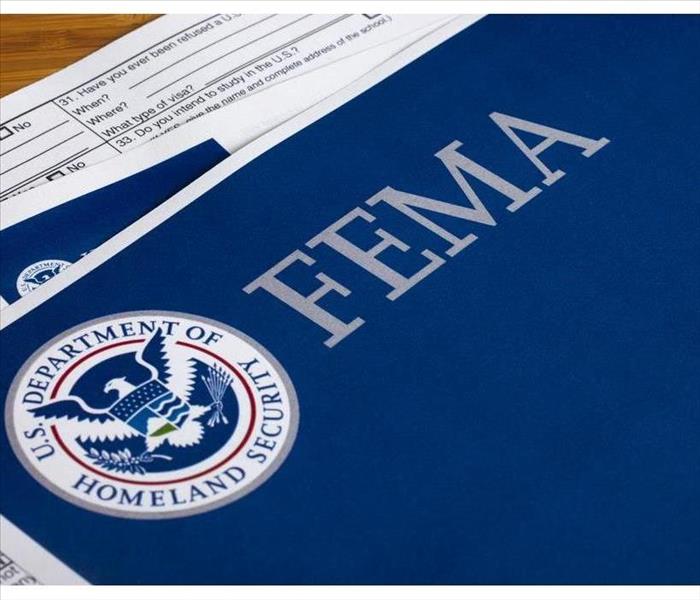 The Federal Emergency Management Association can also help you after a storm
The Federal Emergency Management Association can also help you after a storm
2 Ways FEMA Can Help You After a Storm
Experiencing a major storm or flood in your Bixby, OK, home can be devastating. Your home and personal belongings have likely suffered significant damage and it can be stressful figuring out what steps to take to begin to recover. Fortunately, the Federal Emergency Management Association (FEMA) can assist you with assessing the damage both outside and inside your home.
Assess the Damage Outside Your Home
In addition to offering shelters for people after a storm, FEMA can send an inspector to your home to evaluate the extent of damage. Here is an overview of the process:
Contact the organization and fill out the online application for disaster relief assistance.
Once you’ve been notified of acceptance, they will send an inspector to your home. These individuals have experience with various types of disasters and know what to look for.
The inspector will look for structural damage and identify areas that must be repaired in order to make the home inhabitable again.
Be sure to keep your scheduled appointment.
In addition to working with the Federal Emergency Management Association, you should also contact your insurance agent if applicable.
Assess the Damage Inside Your Home
Before allowing anyone to enter your home, verify that the inspector is wearing an official FEMA badge. The inspector will want to see proof of home ownership but they won’t ask you for any money or credit card information. After paperwork is completed, the inspector will go room by room taking pictures and documenting damage caused by flooding. You can ask to look at the documentation to make sure that details are complete and you’re satisfied with the thoroughness of the inspection.
Suffering through a residential storm is traumatic. While it may seem impossible to get your home back to normal again, a storm damage professional can assist with flood cleanup. The Federal Emergency Management Association can also help you after a storm.
Avoid Lingering Odors After the Flood
10/26/2019 (Permalink)
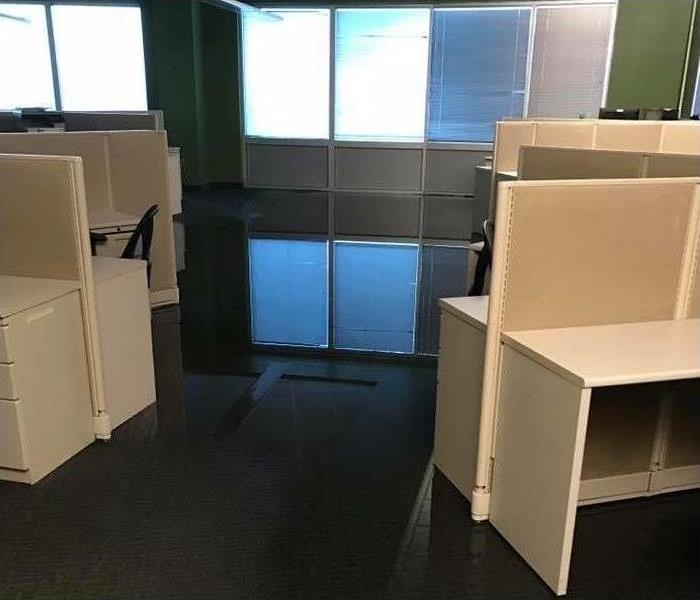 Flooded office in Liberty, OK
Flooded office in Liberty, OK
After flooding in Liberty, OK, business owners want their properties back in shape as soon as possible. Even after the water subsides and the visual cleanup has happened, flood water damage can leave some hidden problems, such as mold, that may only present themselves as an odor.
Floods Aren’t Just Regular Water
Unless flooding has occurred from a main water pipe with clean water, there’s a high probability that the water contains sewage loss and other bacteria. Cleaning up this type of water damage requires more than a simple wipe down. A professional restoration company has the expertise to know where to look and how to clean up damage that could be overlooked. Places that can retain odors or result in mold growth include:
- Air – The air itself contains mold spores that can easily spread to unaffected areas if not properly eradicated.
- Furniture – Mold and bacteria love porous materials, especially fabric and wood. After a flooding, identifying and removing items that have come in contact with flood waters is important. After drying them out, the will need to be thoroughly cleaned.
- Floors and Walls – Even if it doesn’t seem like the water reached a section of carpet or tiles or only went up an inch on the wall, water can sneakily travel without being noticed. Depending on the damage, sections may need to be replaced to completely ensure the damage doesn’t spread.
Why Mold Lingers
Mold growth happens fast and can be easy to visually overlook though easy to smell. Within 48 hours of flooding, mold spores can take root and begin to form. If their cycle goes unchecked, new mold spores will spread to unaffected areas and create new patches of growth. If this happens behind drywall, it may not be noticeable until the waste gases mold produces permeate your sense of smell with its musky, earthy odor.
If that odor persists, it’s likely that mold growth is still happening after the cleanup. Getting the right help from the beginning can ensure your flood experience doesn’t linger.
Tips to Keep Pumps Running Smoothly
9/10/2019 (Permalink)
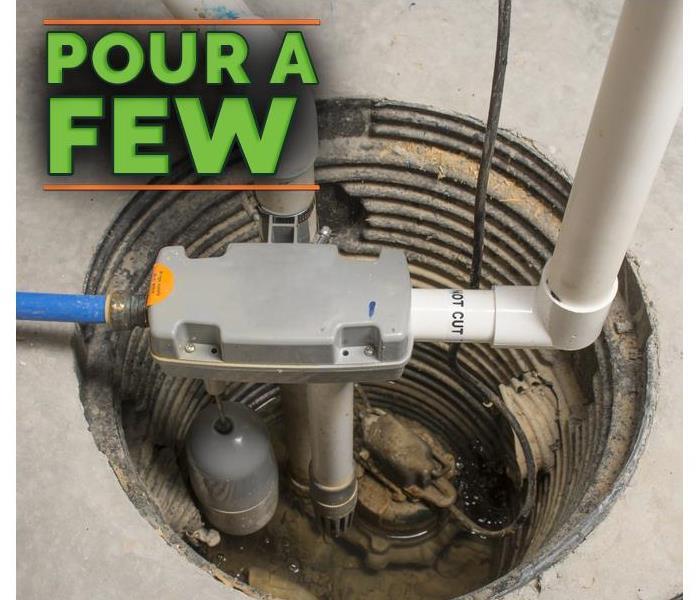 Regularly test pump by dumping water into the pit and basin
Regularly test pump by dumping water into the pit and basin
After a winter thaw or heavy rains in Woodland Hills, OK, the ground around a sump pump can become saturated. If more rain is in the forecast, these systems can help keep a basement from turning into an unwanted swimming pool. Like any system, proper maintenance is needed to ensure they work properly.
How It Works
These systems have collection system, tank, pump and outlet drain. Buried drain rocks or tiles collect and carry water to the tank, or tanks, typically housed in the basement. If groundwater rises to a certain level, a float or switch will activate the pump, keeping excess water from turning into a flood.
Avoid Common Problems
Although one hopes they won’t need to use the system, if the occasion does arise, regular pump maintenance provides peace of mind that it will do what it’s supposed to. If it doesn’t fire up, common issues may include a power failure, stuck switch, old system, clogged pipes or overwhelmed pump. Additionally a system not installed by a professional could mean it is faulty or improperly installed.
Don’t Ignore Preventive Maintenance
A sump pump is composed of mechanical parts, which means they need to be inspected regularly. Making an inspection part of your to-do list is an easy addition compared to the potential problems an overflow could cause.
Verify it is plugged in, preferable into a ground fault circuit interrupter (GFCI) outlet, and is standing upright.
Inspect cord for any damage.
Clear vents, intake screen and discharge pipe of any debris.
Regularly test pump by dumping water into the pit and basin. Ensure float rises and triggers the pump.
Check that outlet pipes are secure and draining away from home.
If you have a sump pump, the chances are you live in an area prone to flooding or excessive water. Being proactive is an easy way to take care of your investment and prevent water headaches down the road.
4 Tips for Handling Flood Damage Safely
7/9/2019 (Permalink)
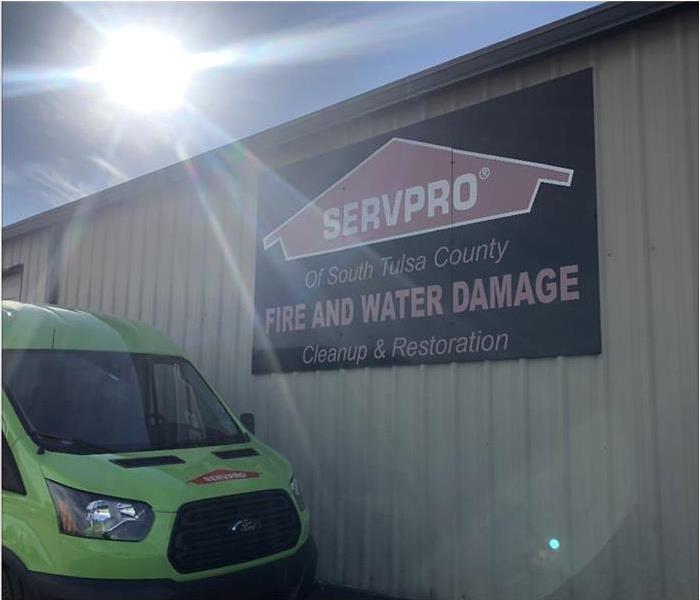 Call remediation experts in Burning Tree, OK
Call remediation experts in Burning Tree, OK
Flood Safety Basics
When something goes wrong in your home, your first instinct is probably to dive in and fix it. When your home floods, however, this may not be the best plan. Flooding in your home in Burning Tree, OK, can create various hazards, so it's important to remember some flood safety basics.
1. Cut Electricity
Electricity and water can be a dangerous combination. One of the first things you should do when your home is flooded by a storm is shut off the main breaker. You won't need the electricity while you are staying elsewhere, and turning it off keeps everyone who has to enter safe from shock.
2. Use Protective Gear
If you have standing water in your home, the best course of action is not to enter it. If you need to do so, however, one of the safety tips you should follow is to wear protective gear. You can't tell what contaminants are in the flood water just by looking at it, so put on rubber boots, coveralls, goggles, a respirator mask and rubber gloves first.
3. Call Remediation Experts
Flood mitigation specialists are experts when it comes to flood safety. They can identify and remove major hazards from your home so that you and your family are protected. They tackle the water damage problem so that you don't have to handle it alone.
4. Vacate Until Restoration Is Complete
As difficult as it may be, the best thing you can do after clean-up technicians take over is to leave. Giving them the space to concentrate on the job at hand can help speed up the process. Find other accommodations until your home is restored to the way it was before the deluge.
If your home has water damage from a storm, flood safety should be your top concern. Following these tips can keep you and your family safe while the experts do their job.
Protect Your Windows
4/26/2019 (Permalink)
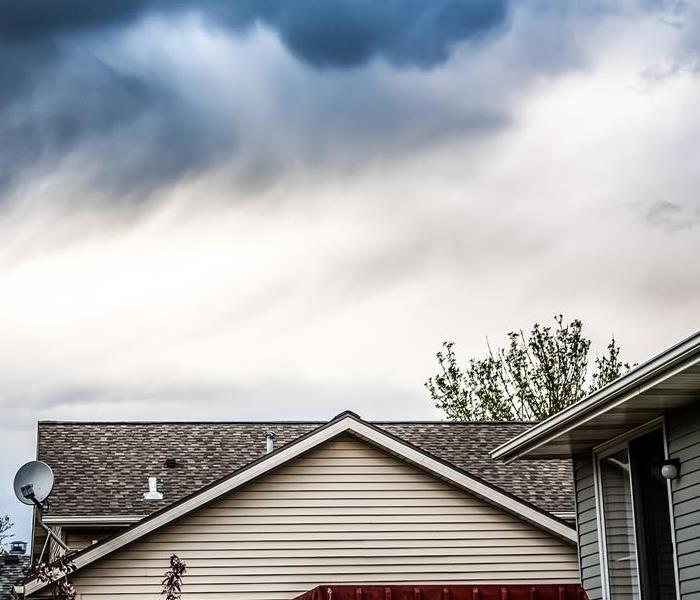 Some homes in Tulsa, OK may be especially susceptible to high winds.
Some homes in Tulsa, OK may be especially susceptible to high winds.
Some homes in Tulsa, OK may be especially susceptible to high winds. However, you don’t have to sacrifice style and comfort to prevent windblown glass and exposure to the elements. Examine the following shutter designs to choose the best one for your home.
1. Traditional Designs
When many people picture shutters, they imagine a wooden frame on either side of the window with rows of slats. This is called the colonial design, and it is so common that many homes use a non-functional version as a decorative window accent. However, depending on the conditions in your area, the colonial shutter variety might be a solid choice for storm protection as well. Another traditional design called the Bahama shutter has vertical hinges, allowing it to open into a small awning to provide shade in warmer climates.
2. Modern Equipment
Other homeowners choose a sleek and compact look to keep their shutters out of the way when no high winds are present. Accordion and rolling shutters are made of light metals or polycarbonate, giving them a high degree of strength and flexibility. This enables the window cover to fold away or roll up when not in use. These designs are typically more expensive than the traditional varieties, and can even be electrically-powered for added convenience.
3. Temporary Protection
Storm panels and plywood are another window damage prevention method for those in high-risk locations. These storm shutters are not intended for permanent installation, and properly speaking, they do not “shut” over the window at all. Storm panels are corrugated metal surfaces that are simply affixed to the window frame with screws. Plywood is an even cheaper solution and can be implemented faster, but may not be as secure.
Whatever shutter option you choose, remember that protecting your home against high winds is the first step toward avoiding interior flooding. Have the contact information of a qualified water damage restoration service ready if you anticipate severe weather conditions.
What Black Water is and How to Deal With it
2/25/2019 (Permalink)
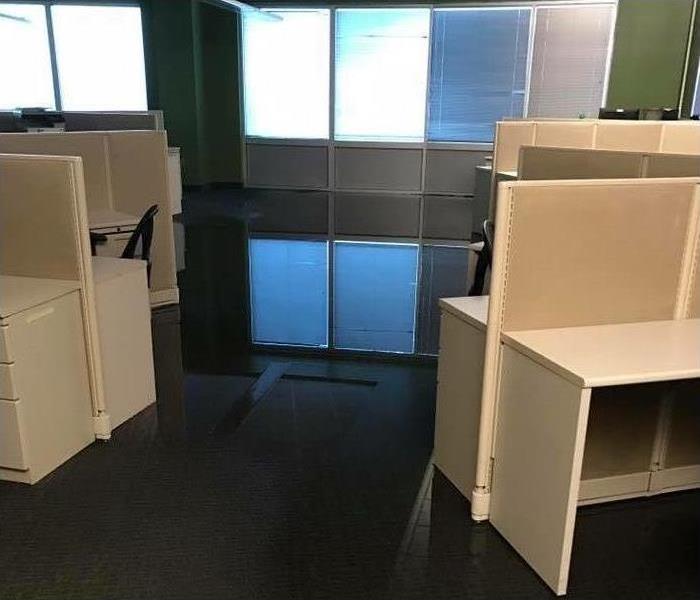 Flooded office damaged by severe storms
Flooded office damaged by severe storms
What Black Water is and How to Deal With It
After a storm and during floods, you may hear the term black water being tossed around. Water damage can be devastating, but it’s worse when this type of water is involved. Not only can your structure be ruined, but the contaminants in the water can make people sick. Here’s what you should know.
1. What It Is
Black water is more common than you might think. It is simply waste water. This water is full of biological material, such as sewage. While it may be easy to think that you won’t have to be in contact with it, keep in mind that it can be present in your drain, sink or toilet if they are backed up. When it comes to water damage, you have to stay diligent.
2. When to Remove It
You should never try to remove black water on your own; it is highly toxic. While there are some aspects of flood damage that can be repaired by you, there are still aspects that you should never deal with without expert assistance. For your health, make sure that you have a professional to contact in case of a flood in your business. They have specialized equipment that helps them to remove the waste safely.
Water damage can be bad enough when there’s a flood in Tulsa, OK. It can be even worse when it comes to waste water being anywhere in your commercial building. You and your employees rely on your business location to be safe. Work with a water restoration specialist to be assured that this type of water is removed safely. Visit http://www.SERVPROsouthtulsacounty.com for more information on water damage.
Tips for Protecting Your Property from Flood Damage
2/12/2019 (Permalink)
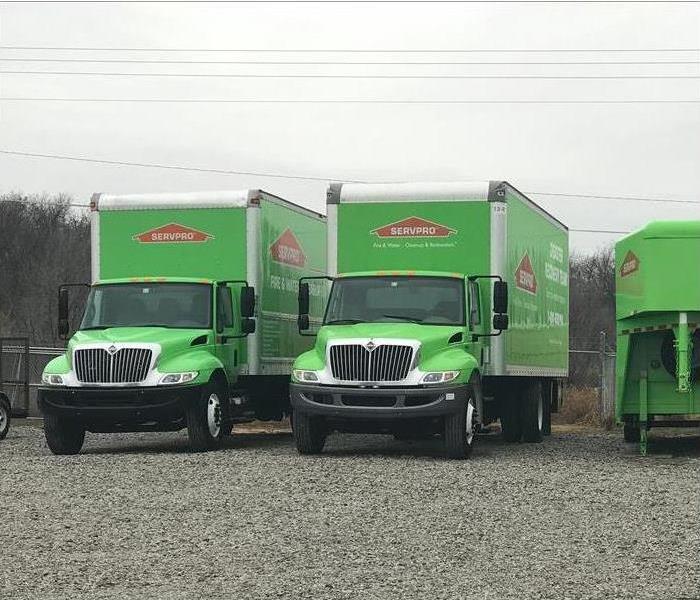 SERVPRO of Tulsa is always ready to respond to your emergency.
SERVPRO of Tulsa is always ready to respond to your emergency.
Flood damage can seem like a remote, theoretical risk – that is, until it’s in your face. Fact is, experts have estimated flood costs for the globe’s 136 largest coastal cities could cost $1 trillion annually by 2050. Wise property Tulsa, OK, property owners are thinking ahead by creating a flood plan. Not sure how to protect your property from storm damage and flooding? Here are a few tips.
About Floods
Federal officials define flooding as partial or complete inundation of 2 or more acres of normally dry land area or of 2 or more properties. Typical causes include:
- Overflow of inland bodies of water
- Rapid accumulation of surface runoff
- Mudflow
All can create damage, but even just an inch of water can result in recovery costs estimated to average $27,000. Being prepared won’t eliminate the risk, but it can help minimize the costs of recovery.
Inspect Your Property
Part of flood-proofing a building is making sure that you inspect it regularly. Look for cracks in the foundation or other structure systems that could be vulnerable in high waters. Also check:
- Flood panels, to ensure the panels or gaskets are working
- Drainage systems for signs of damage that could prevent the pipes from draining properly
Apply Waterproof Sealants
Invest in waterproof coatings and sealants and apply thoroughly to foundations, walls and even doorways of your property. This so-called “dry flood-proofing” measure can form a thin but sturdy barrier that can minimize flood damage effects.
Invest in Water Pumps
Foundation vents encourage water to flow through a building rather than pooling around it, reducing the pressure flood waters can put on walls. This type of “wet flood-proofing” is particularly useful in buildings with basements.
Flood damage can be devastating both physically and financially. Get ahead of the risk with these tips and by identifying a local water cleanup specialist in case the worst does happen.
Tornadoes hit Oklahoma and Arkansas Wednesday
12/7/2018 (Permalink)
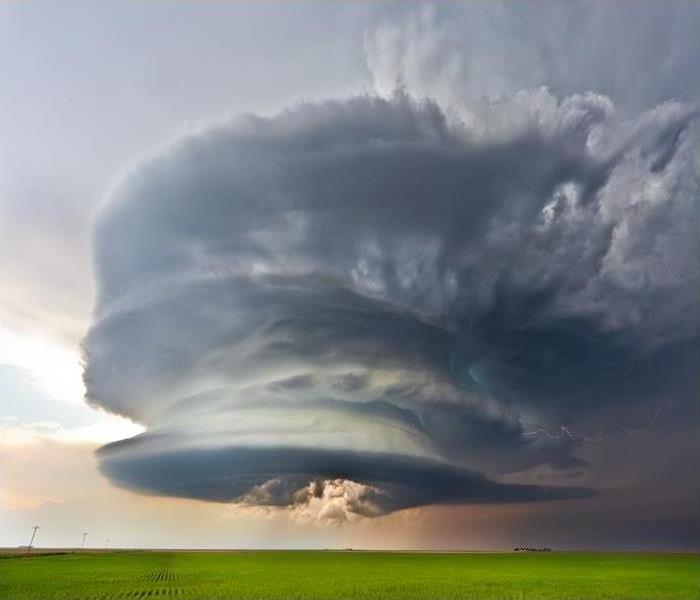 Bad storms need the air to be both warm and moist and that wasn't the case for most of March.
Bad storms need the air to be both warm and moist and that wasn't the case for most of March.
Oklahoma Tornadoes
On Wednesday, one individual was killed and many others were injured as the result of different tornadoes that ran through Tulsa during its evening rush hour. According to Tulsa County Sheriff's Capt. Billy McKelvey, one person was killed in their mobile home near the suburban Sand Springs. The whole Sand Springs area was practically destroyed Wednesday during the intense weather.
As of now, it is not certain whether or not the death was the result of the tornado itself or straight-line winds that hit the park. McKelvey stated that the park could hold anywhere from 40 to 50 trailers at a time. Overall, though, 15 people were believed to have been hurt from the storm. However, McKelvey does not have an exact number yet. "It could have been much worse," he said.
Tornadoes didn't just hit Tulsa, they were seen elsewhere in Oklahoma. There were also some tornadoes at this time in Arkansas, although there were no injuries reported from those. Back in 2013, Oklahoma was also dealt with fatal tornadoes when one went through parts of Moore. This Oklahoma City suburb was faced with 24 deaths from this EF5 tornado. Before Tuesday, it had been over a month since the last time the United States saw a tornado.
Much of the damage caused from these tornadoes could be seen on television. The news showed video from Wednesday evening where roof damage was evident throughout a Moore neighborhood. In fact, the glass door that is on the Tulsa building that is home to the National Weather Service was completely smashed. A bunch of cars in the parking lot even had their windows cracked.
Don Ruffin, a resident in the Moore area, said that he was with a neighbor at a local convenience store when he saw the tornado quickly coming closer. "I don't know how close it was to us, but it looked like it was coming toward us, and so we didn't take any chances," Ruffin said. "We got in our vehicles, ran home and got in our shelters." Ruffin said once the storm was over, there were some fences on the ground and "patio furniture thrown everywhere."
The Oklahoma Department of Emergency Management made a note that statewide, there were roughly 80,000 power outages reported. The Oklahoma Highway Patrol also reported that there was an overturned tractor-trailer on Interstate 35, which had completely stopped all traffic.
The tornado season usually kicks up for most parts of the United States in March, but thanks to the weather patterns Oklahoma was experiencing these storms weren't much of an issue before this past week happened. Bad storms need the air to be both warm and moist and that wasn't the case for most of March. However, this week southerly winds turned the temperatures into the 70s and 80s range for these areas. Weather fronts then took that air and transformed them into Wednesday's storm.
While the tornado in Oklahoma was categorized as a EF5 tornado, the one that hit northwest Arkansas on Tuesday night will likely be classified as an EF0. An EF0 is the weakest level of a tornado, with wind speeds coming in at anywhere from 65 to 85 mph. Meteorologist Jeff Hood from Little Rock said that this tornado was actually a waterspout, which means it never even made it onto land. Instead, it formed completely over water.
Prior to this week, there were only about two-dozen twisters total for this year. Typically, this number is about 120. The last time that the Storm Prediction Center is reporting that the United States had no twisters in March was about 50 years ago.
5 Steps in Maintaining a Sump Pump
9/14/2018 (Permalink)
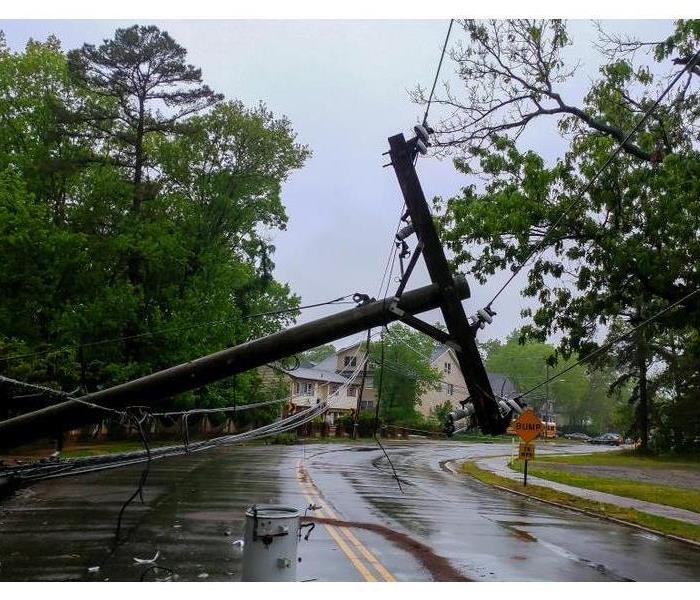 You should have a backup plan in case you lose power during a storm in Tulsa, OK.
You should have a backup plan in case you lose power during a storm in Tulsa, OK.
A sump pump plays a critical part in preventing groundwater from intruding into the basement or crawlspace of your home. This pump should be fully functional during flood or storm conditions. Follow these five pump maintenance steps to ensure your pump stays in working order.
1. Inspect Your Pump Before Heavy Rains
The pump should plug into a ground fault circuit interrupter outlet and should be standing upright. Try pouring a bucket of water into the pit. The pump should start automatically, and the water should drain. If the pump is not operational, schedule repairs as soon as possible or rely on a back-up method.
2. Clean the Grate on Submersible Pumps
Raise the submersible pump and clean the bottom grate on a regular basis. The sucking action can pull small stones into the grate that block the inlet and cause damage over time.
3. Schedule Annual Maintenance
Groundwater tends to rise due to snowmelt or precipitation in late winter or early spring. This is an ideal season to make sure your pump is in working order.
4. Familiarize Yourself With the Pump Alarm
Most sump pumps have battery-powered water level alarms. Some systems can send an alert to your cell phone in the event of a flood or pump failure.
5. Consider Installing a Backup Pump
Choose from water-powered pumps that work without electricity, a battery-powered pump that uses a deep cycle boat battery, or a pump powered by a car battery. Or rely on a generator.
These five pump maintenance measures will ensure that the sump pump in your home works properly.
You should have a backup plan in case you lose power during a storm in Tulsa, OK. If groundwater backs up into your crawlspace or basement, contact a residential restoration company to make sure building materials are still viable and to prevent mold. For more information, visit http://www.SERVPROsouthtulsacounty.com/.
How to Check for Roof Damage After a Storm
7/16/2018 (Permalink)
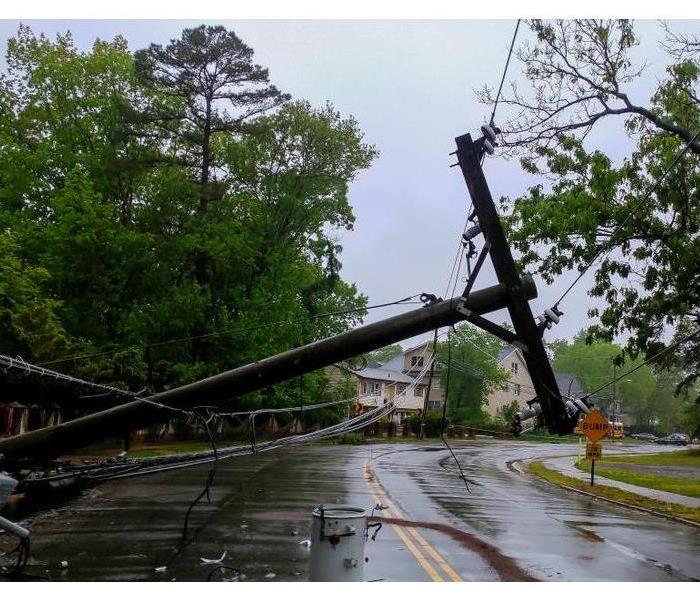 After a major storm, it's a good idea to inspect your property for damage.
After a major storm, it's a good idea to inspect your property for damage.
After a major storm, it's a good idea to inspect your property for damage. Your home's main line of defense is your roof, and it takes a beating. Since it's hard to see your roof, be sure to pay special attention to things like dings in your gutters or tears in your window screens which indicate hail damage. Even from the ground, you may see missing tiles or other signs of roof damage, but most leaks don't represent a need for whole roof replacement. Usually, the leak is coming from something requiring only minor roof repair. Find the source of the leak, stop it and clean the water damage.
Find the Leak Source
During storms in Tulsa, OK, wind damage lets the rain into your roof. From the inside of your home, look for stains that indicate the source of a leak and the area that needs roof repair. You may see water stains on your ceiling or coming down a wall. When you see that, get your flashlight and head to the attic to look for the source of the leak in that area. Here are five common sources for a roof leak:
1. Vents and fans
2. Chimneys
3. Window dormers
4. Vent pipes
5. Unsecured nails and nail holes
Fix Water Damage
To complete your roof repair, start looking for materials that have been damaged by water. Check for discolorations and rotting wood, as well as wet drywall and insulation. If you find mold, you will need to be very careful not to spread the problem during cleanup. A mold remediation professional can help by creating a containment area while working on the water and mold damage. If you haven't found mold, be sure to start drying any wet materials right away. Mold can begin growing on wet damaged materials in as little as 48 hours. Complete drying is critical to preventing mold, and it may take longer than you realize, especially in a humid attic space. Specialists have monitoring equipment that they use to ensure materials are completely dry. For more information, visit http://www.SERVPROsouthtulsacounty.com/.
What You Need To Know About the Flood Cut
6/14/2018 (Permalink)
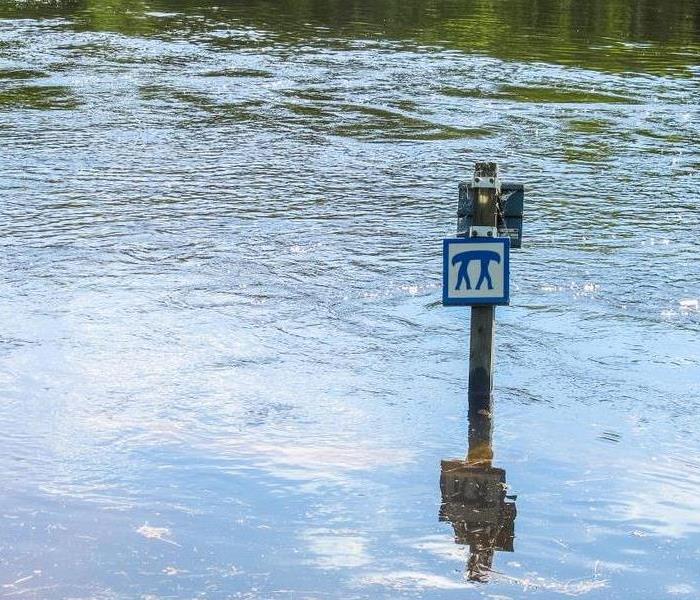 A flood cut may not be ideal, but it is better than further contamination.
A flood cut may not be ideal, but it is better than further contamination.
If your building was recently flooded, your Tulsa, OK, water restoration team has probably informed you that they need to perform a flood cut. While that may sound bad—after all, anything with the word "cut" in it cannot be good right?—it's actually a relatively simple and inexpensive procedure. It's also often necessary post flooding.
What is a Flood Cut?
A flood cut is a procedure performed to separate the damaged sections of a wall from the undamaged sections. It is necessary for several reasons, the biggest of which is that it prevents further contamination. Most professional flood cuts are made 12 inches above the water damage line. Any less and you risk adulteration despite having made the cut. After a flood, flood cuts are performed to:
• Remove all traces of water damage and restore your building to pre-flood condition
• Ensure that all contaminants are removed both internally and externally
• Get rid of all accumulated bacteria
• Restore walls to pre-flooding appearance
A flood cut is not always necessary, but it is common. Usually, professionals recommend flood cuts when flood water is categorized as two or three flood water. Category two water refers to water that contains known contaminants, such as water from a dishwasher or washing machine. Category three water refers to black water, or water from sewage backup. The goal of drywall cut is to get rid of contaminants and ensure that a home or building is safe to return to after a flood.
Flood Cuts Prevent Further Damage
A flood cut may not be ideal, but it is better than further contamination. If want to ensure that your building is safe for occupants, and if you want to prevent a major restoration such as a complete wall tear out, talk to your Tulsa, OK, storm restoration team about performing a flood cut. A flood cut may be the quickest way for you to return to business as usual post-flooding. For more information, visit http://www.SERVPROsouthtulsacounty.com/.
5 Reasons To Board and Tarp After Roof Damage
4/17/2018 (Permalink)
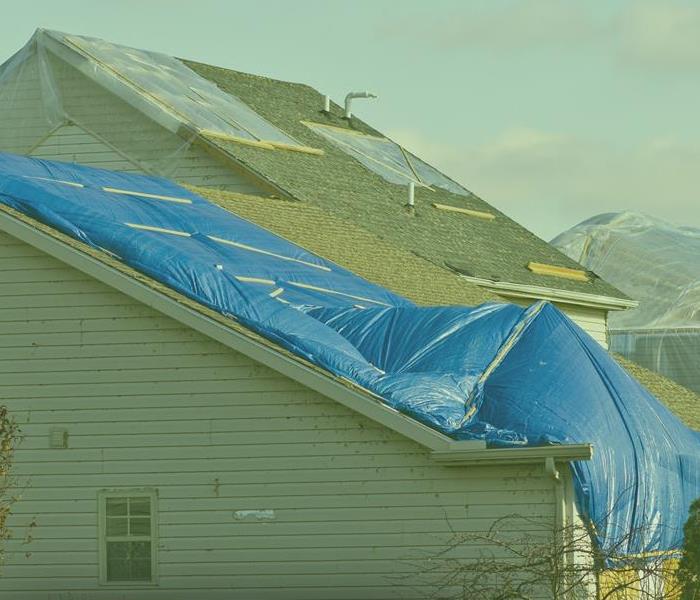 To ensure the boarding and tarping are properly done, work with experienced restoration specialists.
To ensure the boarding and tarping are properly done, work with experienced restoration specialists.
Roof damage in Tulsa, OK, is not uncommon after a major weather event, such as heavy storms or snow. Unfortunately, some homeowners do not take steps immediately after an event to prevent the damage from worsening. However, tarping or boarding could potentially help mitigate the damages. In addition to preventing further damage to the roof, there are five other reasons to use boards or tarps.
1. The cost of the repair can increase. The longer the damaged roof is left exposed to environmental elements, the more damage can occur. Potentially preventable problems could lead to a balloon in your costs.
2. The home is vulnerable to vandals. Depending on the extent of the damage to your roof, there is a possibility that vandals and robbers could gain access to your home and destroy or steal your possessions. Tarping and boarding your home could be the deterrent you need.
3. Unwanted pests could enter your home. Pests, such as roaches and rodents, can sometimes find their way into your home through openings that are left by wind damage and roof damage.
4. Guests could be injured by the roof. Until the roof has been professionally assessed by restoration specialists and properly boarded and tarped, anyone who visits your home could be at risk of injury from falling parts from the roof. One incident could lead to a lawsuit or a claim against your homeowner’s insurance.
5. Your insurance provider may require mitigation. Depending on your insurance policy, there could be a provision that requires you to take steps to mitigate the damage to your roof. If you fail to act, your claim may be denied or the settlement offer reduced.
By acting immediately to mitigate your roof damage in Tulsa, OK, you could potentially save on the costs of repairs and avoid more serious consequences that can result from waiting. To ensure the boarding and tarping are properly done, work with experienced restoration specialists. SERVPRO of South Tulsa is here to help with any size storm damage! For more information, visit http://www.SERVPROsouthtulsacounty.com/.
What NOT To Do After Flooding
2/15/2018 (Permalink)
When your home floods it's important to know what to do and what not to do. Flooding can cause some big problems. The best course of action is to act quickly and begin the drying process for contents that might be in standing water.
What NOT To Do After Flooding
- Don't leave wet fabrics in place. Hang furs and leather goods.
- Don't leave books, magazines or other colored items on wet carpet or floors.
- Don't use your household vacuum to remove water.
- Don't use television or other household appliances.
- Don't turn on ceiling fixtures if ceiling is wet, and keep out of rooms where ceilings are sagging.
SERVPRO of South Tulsa County is available 24 hours a day. Check out our other services on our website.
4 Ways to Be Ready For the Next Flood
1/10/2018 (Permalink)
4 Ways to Be Ready For the Next Flood
It is always good to plan ahead for oncoming flooding. Repairing storm damage can cost thousands of dollars if you do not have the right insurance policy. Fortunately, there are various ways to protect your house in Tulsa, OK so that you can evacuate with peace of mind.
1. Waterproof Exterior Walls
It does not take a lot of water to damage a property. It can still take a lot of time and money to repair flood damage that brings fewer than two feet of water inside your home. A waterproof veneer consisting of a brick layer reinforced by a sturdy membrane can help prevent a small amount of flood water from entering your property. In some cases, a membrane can be enough to keep water at bay entirely.
2. Raise Electrical Components
Outlets, meters and service panels should be at least one foot above your home’s flood level. Systems being exposed to even a small amount of flooding can cause them to short circuit.
3. Anchor Fuel Tanks
Clean flood water can become contaminated if a fuel tank sustains damage. An unanchored tank can be swept up by the flood, creating a leak and spilling oil into the basement, which causes a number of problems. It is much more difficult for a professional crew to clean up contaminated water than clean liquid.
4. Clean Gutters Routinely
You should make cleaning the gutters a regular part of your chore routine. Leaves and other debris can get caught in the gutters, and even a small amount of rain can cause the system to break apart. The likelihood of this increases with heavy storms bringing out harsh rainfall. Water can overflow from the gutters, degrading the home’s siding. This water also leaks into the home’s foundation, which can necessitate even more complicated repairs. Prepare sufficiently so you do not fall victim to extreme flooding in Tulsa, Oklahoma. Visit http://www.SERVPROsouthtulsacounty.com for more information on storm damage.
Flooding in Tulsa. What is the best way to be prepared?
12/15/2017 (Permalink)
When preparing for a storm, you might be thinking about flood damage in Tulsa but are you really prepared for it? One of the first priorities prior to a storm is grabbing food and extra water. The second is flashlights and batteries. After you have all the emergency, personal things accomplished, it's time to think about what happens if there's a flood. Will you be prepared?
Being prepared for a flood doesn't only involve sealing the cracks in your foundation or making sure the pump in the basement has enough fuel. There are other concerns like the type of insurance coverage you have on your property if and when a flood happens to you.
Insurance Coverage
Many people are under the impression that their homeowner's insurance covers flood damage. Unfortunately, most policies do not cover flood damage even though they cover storm damage. Flood insurance might need to be purchased separately. If you have flood damage in your policy, find out exactly how much it covers. Will it cover the cost of fixing a sewer backup? Is there a cap on the amount that the policy will cover? These questions are important to ask long before you have a problem.
Contractors
When you have a problem in your home, it's essential that you have a list of contractors that you trust. All the research into contractors' policies, work ethic and reliability should be done before the contractor is needed. The local utility or public works department should have a list of contractors on hand for the public. Don't keep the list without vetting the possibilities before you need to hire them. To find out if your home is at risk for flooding, contact the possible contractors for a walkthrough of your home. This will help you research and become comfortable with the contractor before you ever need their emergency services.
Flooding and the Sewer
When an area floods around your home, it's not only your home that is impacted. The entire area can become overflowing and that includes the sewer. The sewer connections in your home could become backed up and cause unsanitary conditions. When water enters the sewers from a variety of sources during a flood, it's called inflow. The contractor that you hire to do a test on your home can find out whether you have any source of inflow problems long before a flood situation takes place. He'll need to make sure there's a proper backflow valve.
It's a good idea to have a flood or elevation map of the area surrounding your home. Even homes that are not near the coast can have flooding problems. Very dry areas cannot handle sudden heavy rains so they would be a serious problem during a big storm with potential torrential rain. When you're preparing for your next flood, make sure you have the proper help through insurance and contractors before there's a flooding problem.
SERVPRO of South Tulsa County is locally owned and operated and serves Oklahoma City, Edmond, Tulsa, Sapulpa, Okmulgee, Jenks, Catoosa, Sand Springs, Glenpool, Coweta, and the surrounding communities
SERVPRO of South Tulsa County’s fully certified water removal staff can perform a complete damage assessment to your home of office, and then recommend and follow the industries standards to get your water removal restoration repaired properly available 24 hours a day
Why is Water Mitigation Important after flooding?
12/15/2017 (Permalink)
The Importance of Water Mitigation
When a person's home experiences water damage, they will want to reduce the amount of damage that occurs. Water mitigation is the process of preventing damage from water inside a building. The goal is to keep any additional water damage from happening by taking fast and effective action.
Cause And Result
Water damage can happen after a structure has a plumbing failure. It can also result because of storm water. Broken underground pipes have also caused water damage. This has resulted in soaked rugs, warped floors, damaged furniture, walls and more. This is a time when immediate water mitigation steps need to be taken.
Water Damage - Disaster
When a home has a plumbing failure, it is important the main water source be shut off. When flooding happens, work may not be able to begin until water levels have dropped. No matter what the cause, when water damage happens it is essential electrical breakers is shut down. This makes it possible to safely unplug and remove electrical devices. These devices could be on a wet carpet or in areas submerged in water. Aluminum foil should be placed under the legs or feet of furniture in contact with a wet carpet. Curtains and draperies should be removed if in contact with the water or a wet carpet. Immediately remove papers, shoes or other items that could be damaged. Walking on a wet carpet should be avoided as much as possible.
Inspection
Once the source of the water problem has been addressed, it's time for professionals to conduct an inspection. They will be able to carefully inspect the property and determine the extent of the damage. A recovery plan will be created. This will cover the details necessary to return a building back to its original condition.
Water Extraction
Water that damages a building can be contaminated. Water in a home from flooding can be sewage or polluted ground water. This is a situation that could cause severe illness to people and their pets. Pumps and other equipment can be used to remove water. There is a good chance this can be done without removing any of the building's contents. This also includes removing any items soaked with water including tems such as carpeting, furniture and more. Anything that has absorbed water and cannot be restored must be removed.
Drying and Mold Prevention
Water damage can create vast amounts of mold if not handled correctly. It is important to take steps immediately to remove mold and prevent it from reoccurring. This will require using state-of-the-art dehumidifiers and air movers. It will require the humidity inside a building be carefully monitored and controlled. If the humidity is not handled properly, items not destroyed during the water damage could absorb moisture and be ruined. The damaged area must also be kept at an acceptable temperature. Providing an improper temperature is a major cause of microorganism and bacterial growth after water is removed.
Completion
It is important for a structure to be stabilized, and its integrity maintained. Every water mitigation project will be different. It's important to utilize the services of experienced water removal technicians. They will have the proper equipment and experience to restore any type of structure that experienced water damage.
What not to do after flooding
11/21/2017 (Permalink)
After any water damage situation, your primary focus should be safety first:
- Is it safe to stay in the house?
- Electrical and "slip and fall" hazards are some of the most prevalent concerns.
- Only do activities that are safe for you to perform.
- Wet materials can be VERY heavy. Be careful!
What To Do After Flooding
- Remove excess water by mopping and blotting.
- Wipe excess water from wood furniture after removal of lamps and tabletop items.
- Remove and prop wet upholstery and cushions.
- Place aluminum foil or wood blocks between furniture legs and wet carpeting.
- Turn air conditioning on for maximum drying in summer.
- Remove colored rugs from wet carpeting.
- Remove art objects to a safe, dry place.
- Gather loose items from floors.



 24/7 Emergency Service
24/7 Emergency Service































